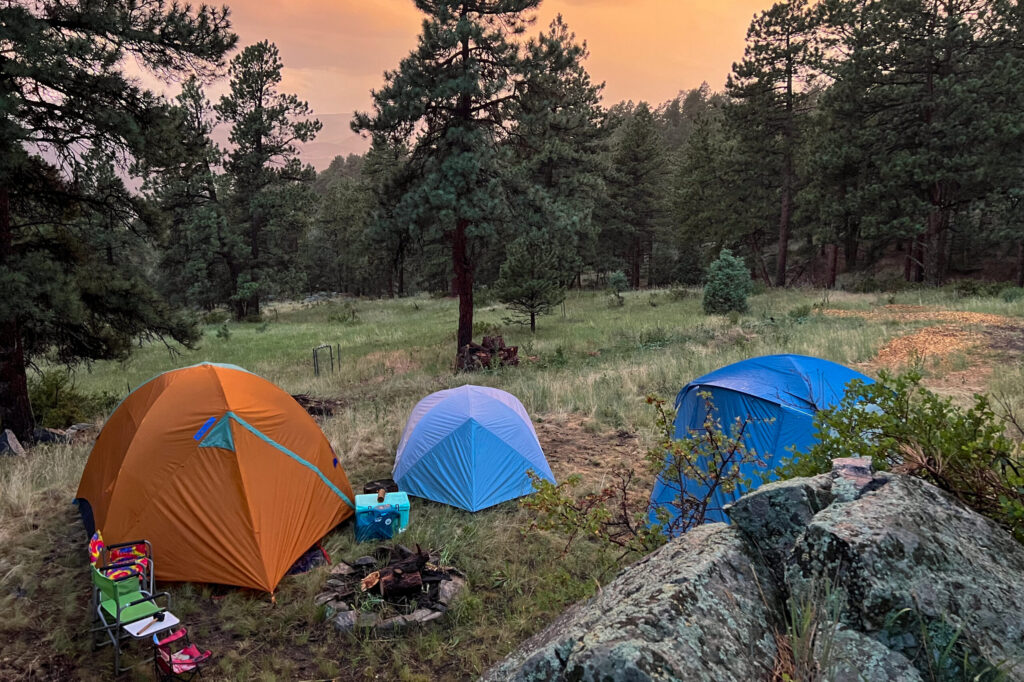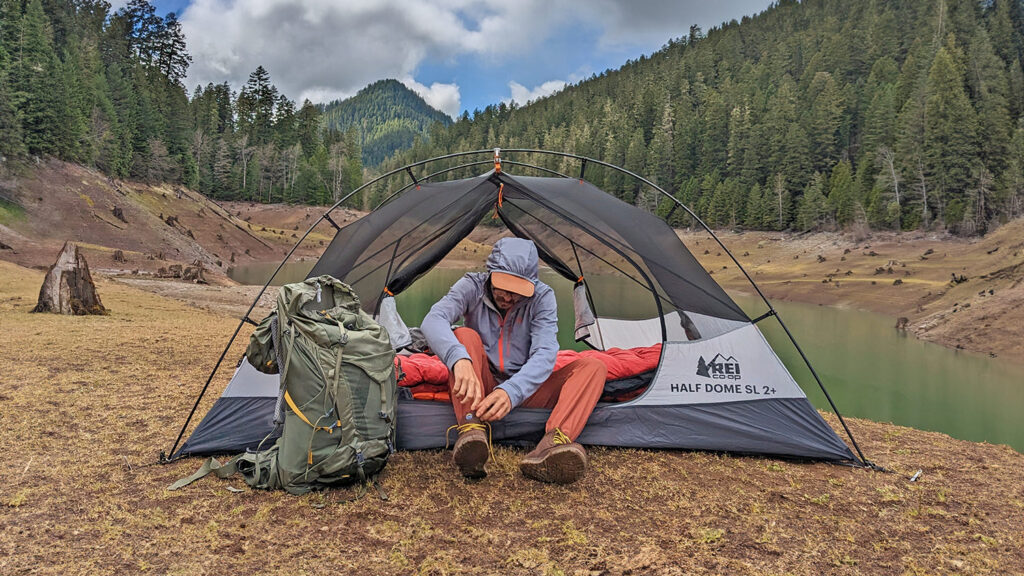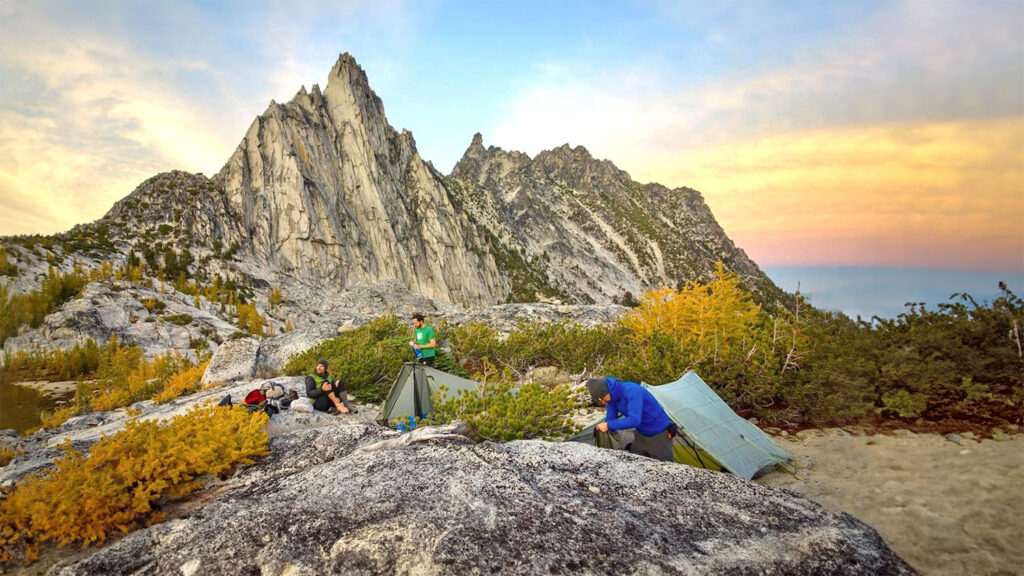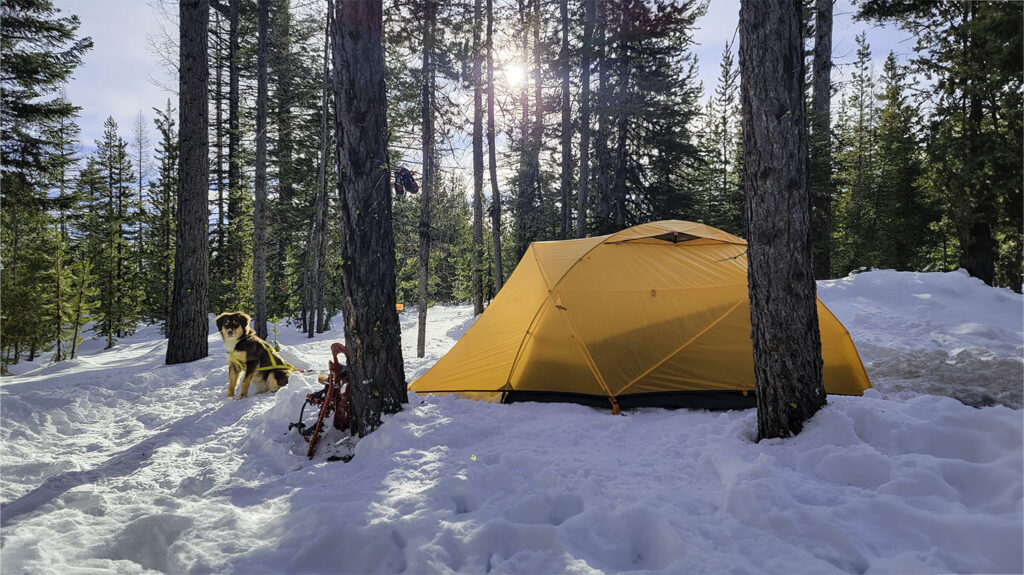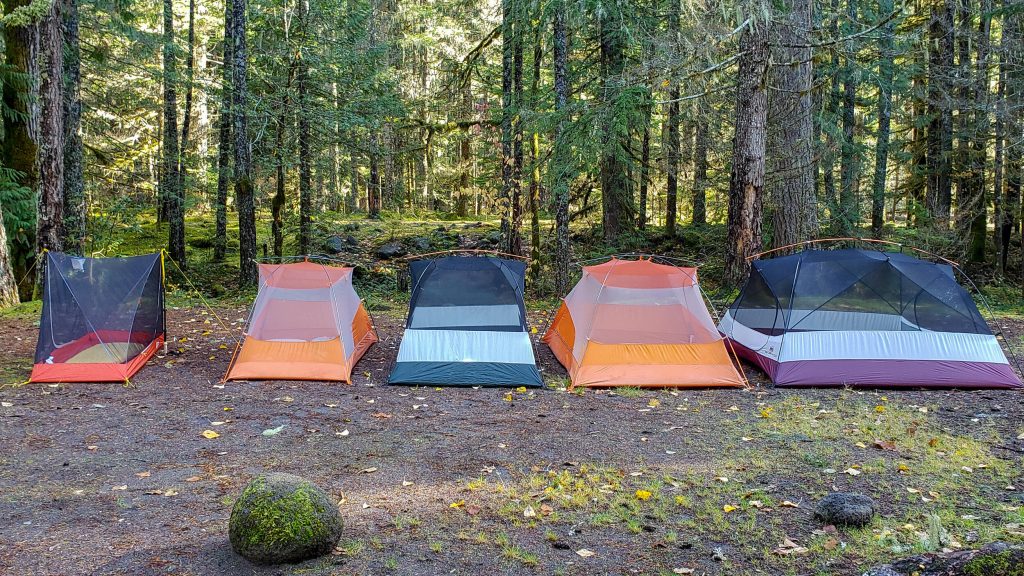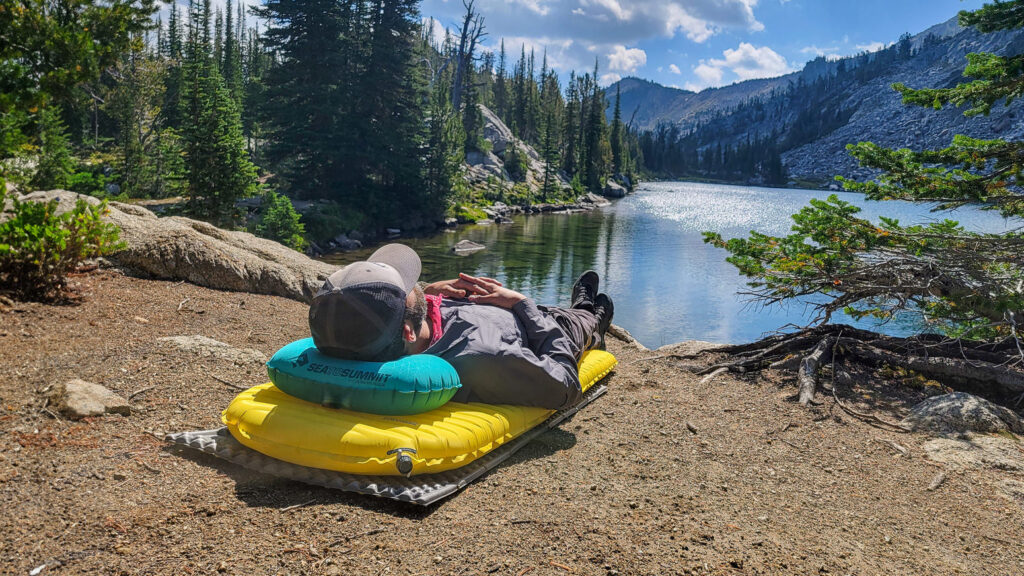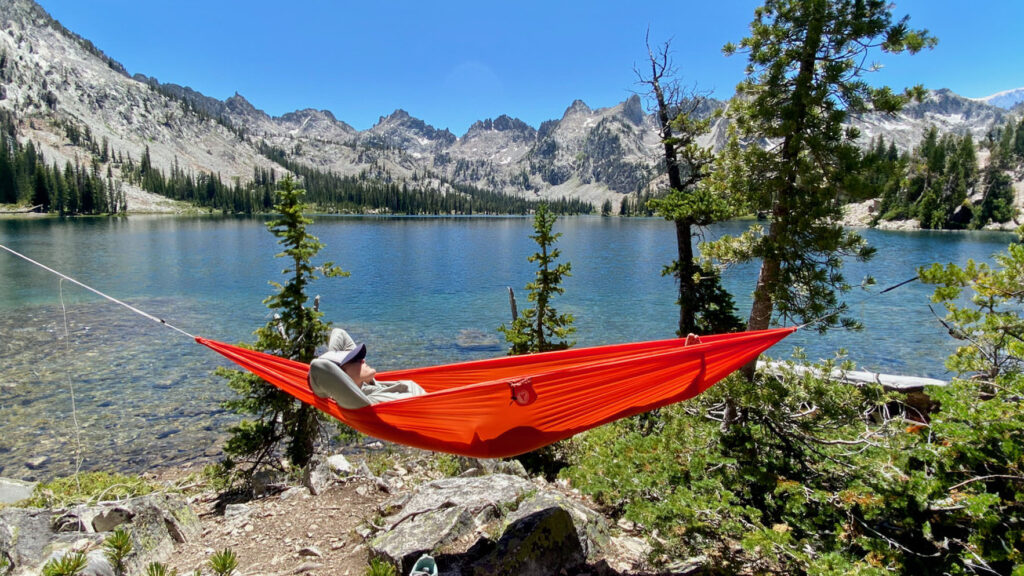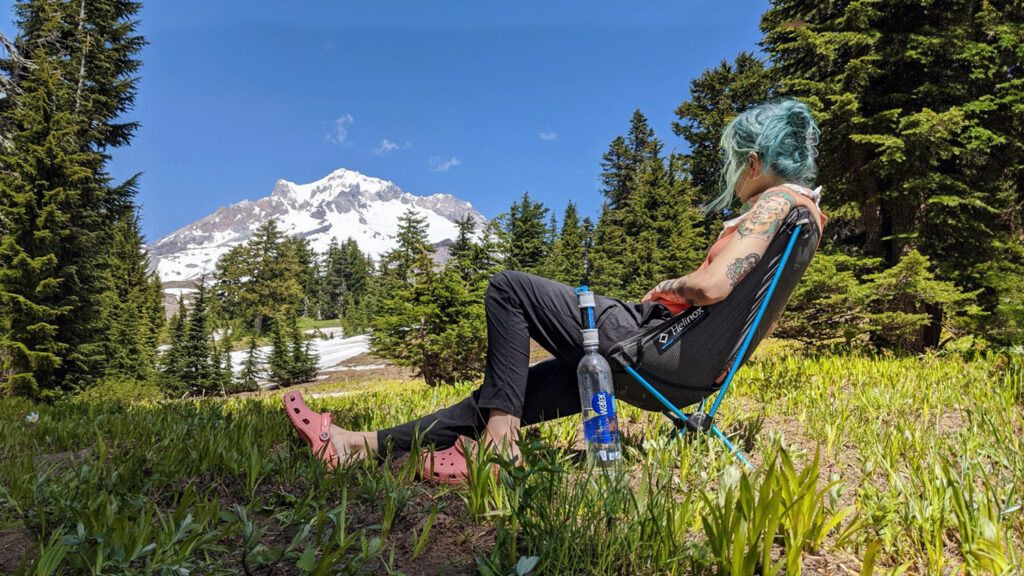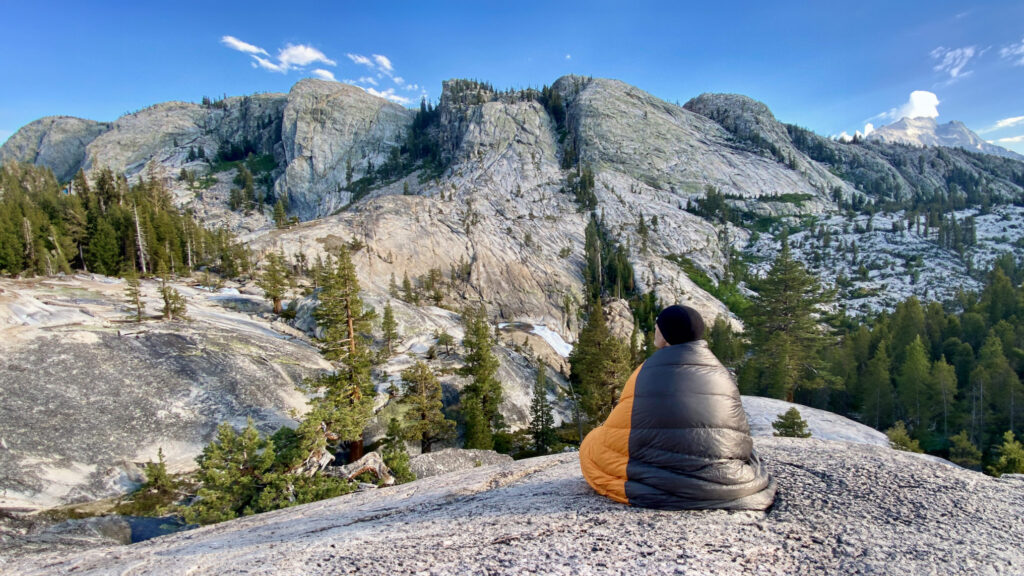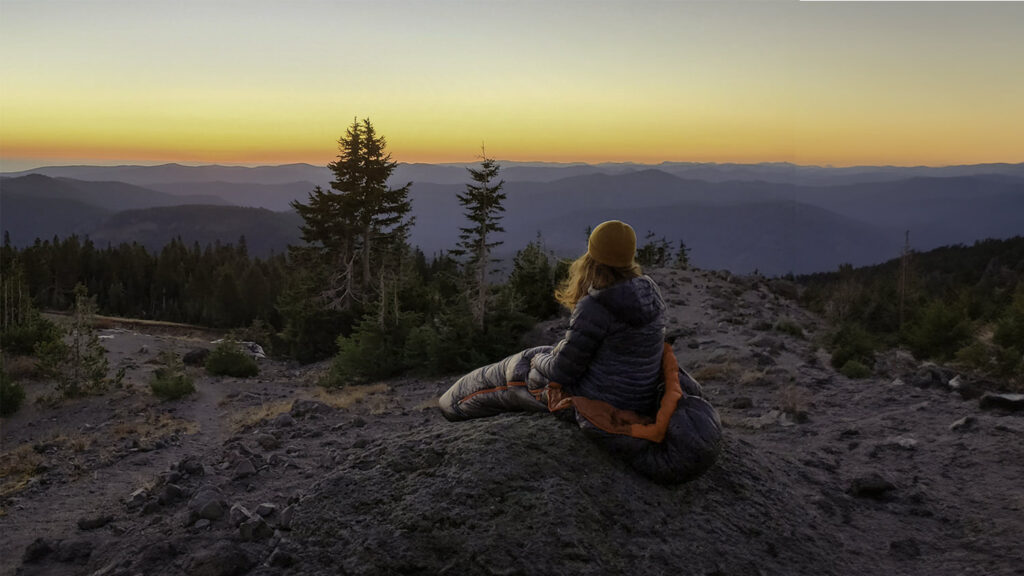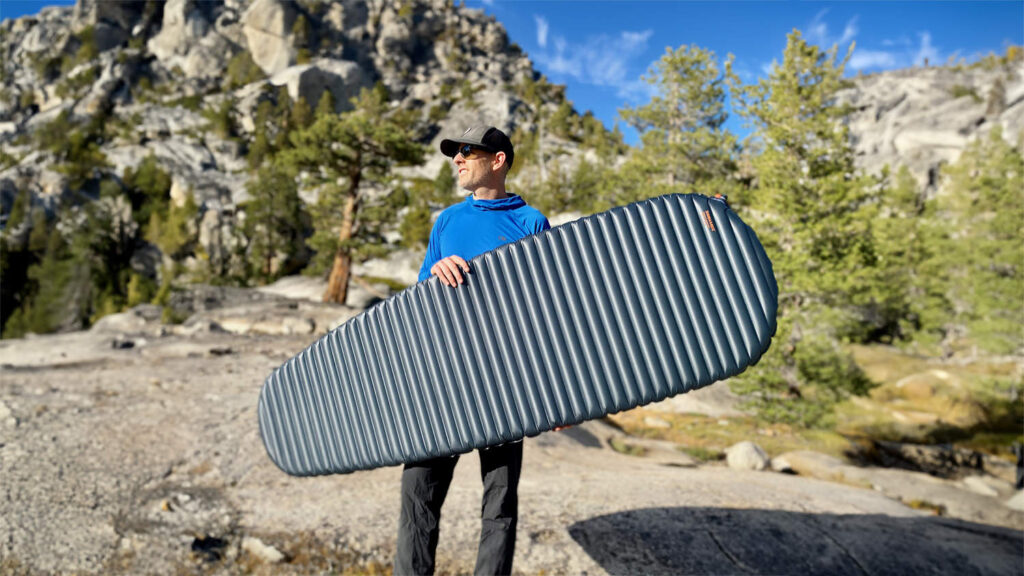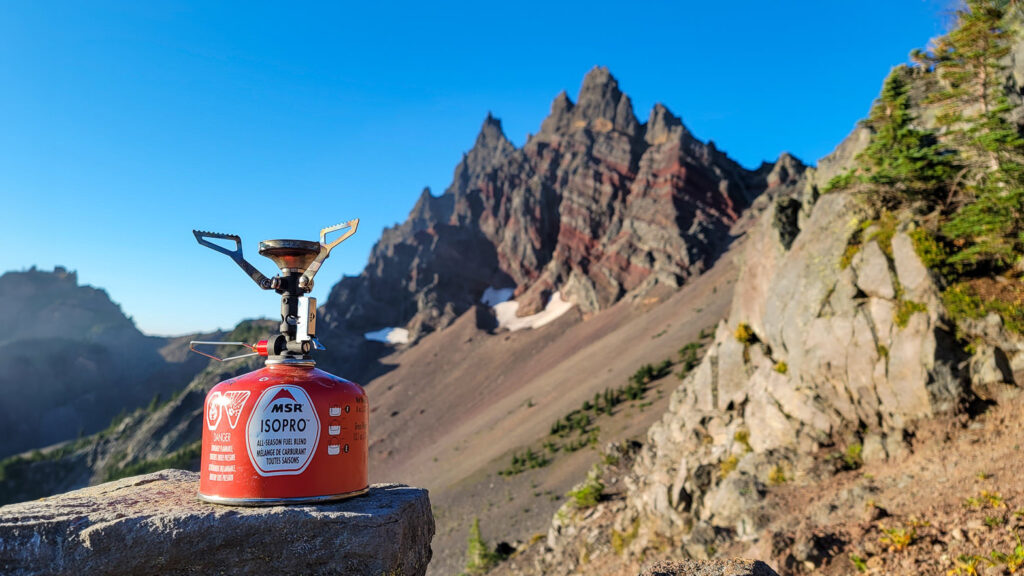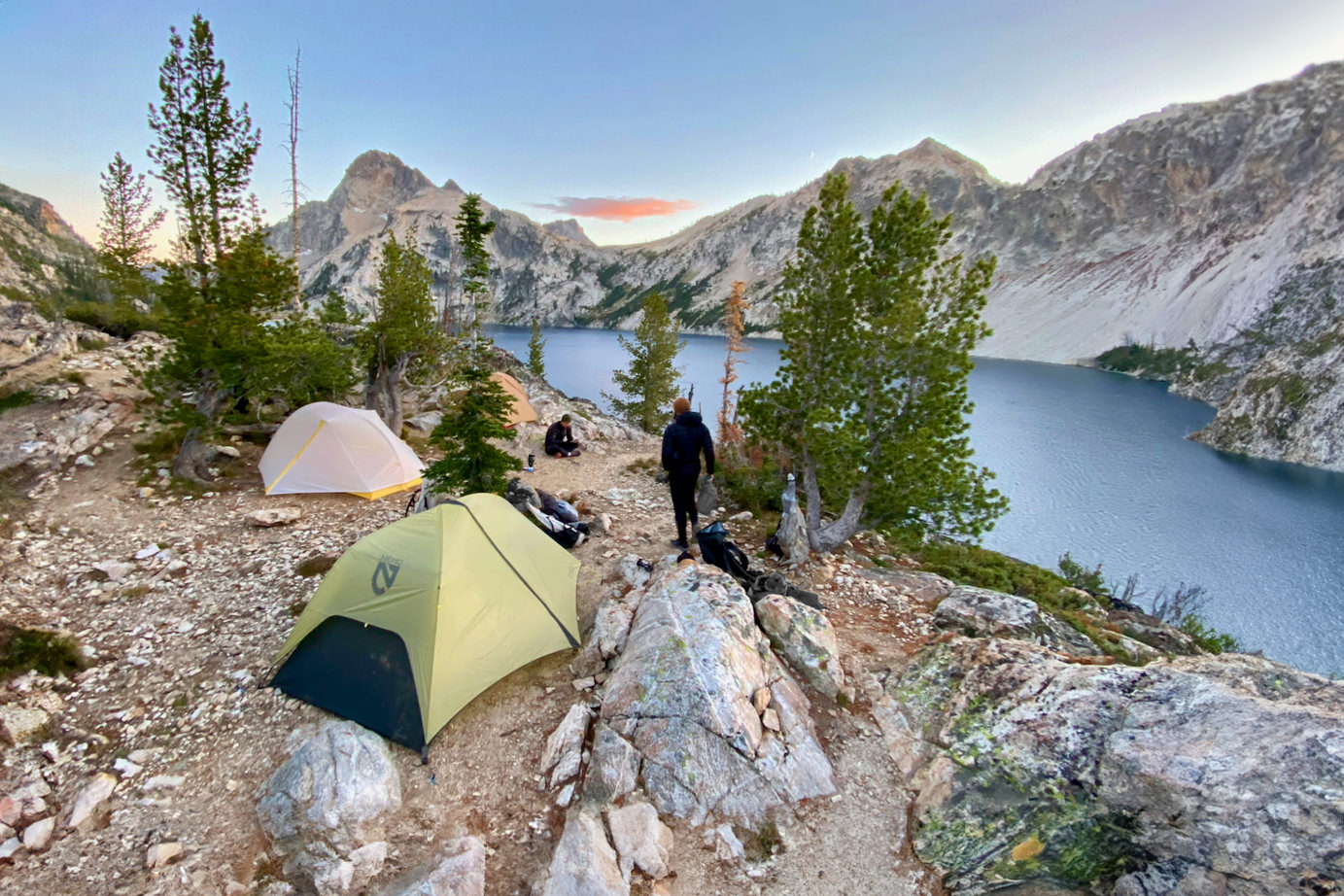
Your backpacking tent will be one of the most important gear purchases you make. Finding one that has the best balance of interior comfort, weight, durability, and weather protection will make it much easier to stay happy and having a good time on trail.
Our team of gear experts has spent over a decade testing more than 50 backpacking tents from brands like Big Agnes, Zpacks, NEMO, MSR, REI, and more. We’ve hiked upward of 20,000 miles on trails all over the world, including treks through the alpine peaks of Patagonia, summer monsoons in the Rockies, and sweltering days in the desert, with more than 1000 nights in the wilderness.
And for more info, check out some of our other most popular gear guides:
Quick Picks for Backpacking Tents
Check out this quick list of the best backpacking tents, or continue scrolling to see our full list of favorites with in-depth reviews.
Best Backpacking Tent Overall: Big Agnes Copper Spur HV UL2 ($530)
Best Ultralight Backpacking Tent: Zpacks Duplex Classic ($669)
Best Semi-Freestanding Backpacking Tent: Big Agnes Tiger Wall UL2 Solution Dye ($450)
Best Budget Tent for Backpacking & Car Camping: REI Half Dome SL 2+ ($349)
Best Lightweight & Sturdy Tent for Harsh Conditions: SlingFin Portal ($560)
Great Option for UL Hikers Wanting More Space: NEMO Hornet OSMO 3 ($550)
Spacious Tent with Innovative Features: Sea to Summit Telos TR2 ($449)
Best Crossover Tent for Backpacking & Car Camping: NEMO Dagger OSMO 2 ($530)
Good Balance of Weight & Livability for Solo Hikers: MSR FreeLite 2 ($450)
Most Affordable Backpacking & Car Camping Tent: REI Trailmade 2 ($199)
Affordable & Spacious Ultralight Backpacking Tent: Six Moon Designs Lunar Duo ($395)
Great Balance of Weather Protection & Weight: MSR Hubba Hubba 2 ($550)
Best Affordable Ultralight Backpacking Tent for One Person: Durston X-Mid 2 ($280)
What’s new
We’ve updated all of our reviews with more long-term testing results after several hundred more miles of experience with each tent over the past year.
- The Big Agnes Copper Spur HV UL2 remains the best overall pick for over five years running.
- We still highly recommend the classic Zpacks Duplex Classic, but we also had a chance to test out and review its sibling, the Zpacks Duplex Zip.
- The REI Half Dome SL2+ remains one of the best deals for a backpacking/car camping hybrid tent.
- The Big Agnes Tiger Wall UL2 Solution Dye continues to be our favorite semi-freestanding backpacking tent.
Backpacking Tents Overall Testing Scores
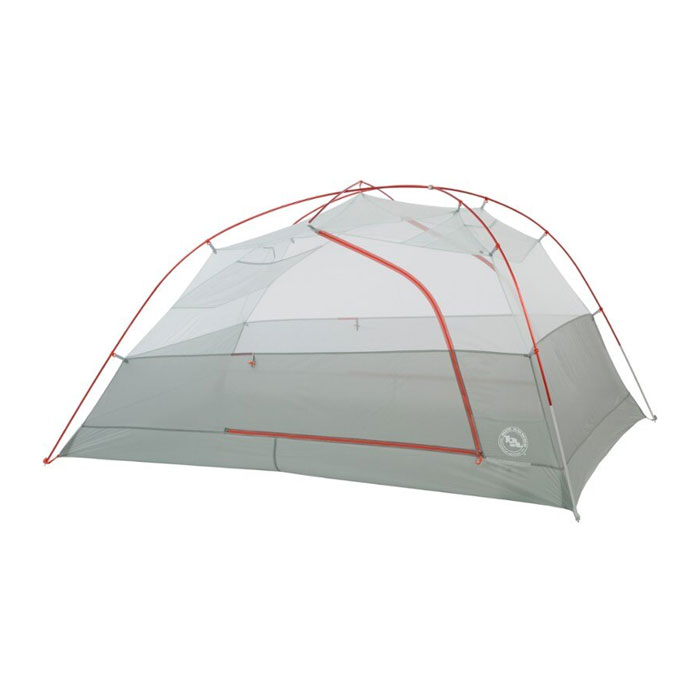
Big Agnes Copper Spur HV UL2
Best Backpacking Tent Overall
CleverHiker Rating: 80.3/100
Price: $530
Packed Weight: 3 lb. 2 oz.
Dimensions (LxWxH): 88 x 52/42 x 40 in.
Type: Freestanding
Pros
- Ultralight for a freestanding tent
- Quick and easy to set up
- Ample headroom
- Very useful pocket layout
- Large doors/vestibules
- Quality construction/materials
Cons
- Expensive
- Rainfly zippers can snag
The Copper Spur HV UL2 is one of our all-time favorite backpacking tents – the CleverHiker team has spent hundreds of backcountry nights in this shelter. Its ultralight freestanding design enables hikers to pitch it almost anywhere, and it doesn’t sacrifice convenience, weather protection, or livability.
The Copper Spur is a popular choice among thru-hikers of the AT, PCT, and CDT, all of which are notoriously tough on gear. Despite the ultralight materials used in the construction of this tent, it can last for thousands of miles if you take the time to clear pokey debris from your campsites. We’ve taken several iterations of the Copper Spur 2 over a thousand miles each on trail, and they’re still going strong.
The bent-pole structure and ridge pole of the Copper Spur create nearly vertical sidewalls – maximizing interior volume and providing ample headroom. The UL2 has enough space inside for two regular-width sleeping pads and some gear. You can even squeeze a tapered wide pad plus a regular pad inside but you’ll likely need to store gear outside in that case.
If you and your hiking partner both use wide pads (or you just prefer extra space), you’ll want to bump up to the Copper Spur HV UL3. Pretty unique in the backpacking tent category, the Copper Spur 2 and 3 are also offered in Long versions. The Copper Spur Long gives you a whopping 96 inches of floor length, so it’s a lot more comfortable for hikers over six feet tall who prefer to store all their gear inside. Whichever size you go with, you’ll have a backpacking tent that provides an exceptional balance of camp comfort and low packed weight.
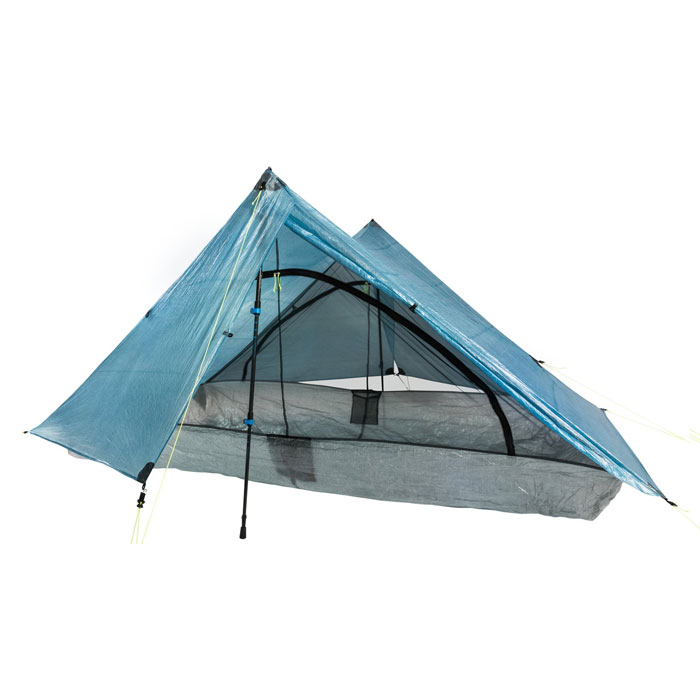
Zpacks Duplex Classic
Best Ultralight Backpacking Tent
CleverHiker Rating: 80/100
Price: $699
Packed Weight: 1 lb. 1.9 oz.(no stakes or poles)
Dimensions (LxWxH): 90 x 45 x 48 in.
Type: Non-freestanding
Pros
- Ultralight
- Very durable for the weight
- Spacious
- Ample headroom
- DCF material won’t sag when wet
- Large doors/vestibules
- Trekking poles can double as tent poles
Cons
- Expensive
- Needs condensation management
- Non-freestanding design has a learning curve
The Zpacks Duplex Classic is our go-to ultralight backpacking tent for thru-hiking and long-distance adventures. This tent provides an excellent amount of interior space and weather protection at a low weight.
The Dyneema Composite Fabric (DCF) is a big part of what makes the Duplex such a great choice for thru-hikes. It’s waterproof, tough, incredibly light, and doesn’t sag when wet; the downside is that it’s very expensive. That said, the Duplex is a very worthwhile investment if you love to backpack light since it can last for several seasons if you treat it with care.
The other key to the ridiculously low weight of the Duplex is its non-freestanding, single-wall design. This eliminates the need for dedicated tent poles (you use your trekking poles to create the structure) and a rainfly. It may take a few pitches to get it perfect if you’ve never used a backpacking tent like this before, but you’ll quickly get the hang of it with a little practice. Condensation can also be a bigger issue in single-wall tents because there isn’t a mesh layer to keep the interior separate from the flysheet, so ventilation and campsite selection become a lot more important.
The high ceiling of the Duplex allows you and your hiking partner to sit up comfortably at the same time, and the two-door design will keep you from crawling over each other to get in and out. If you’re looking for the best ultralight backpacking tent on the market, this is your guy.
The Duplex is spacious enough for two hikers, and it’s an absolute palace for one. But pairs of hikers who really like to spread out should look at the Triplex for even more square footage with a negligible amount of added weight. CleverHiker Founder, Dave Collins, has used both extensively, and the Plex tents are his absolute favorites for big mileage trips and hikes with a ton of elevation gain. For ultralight solo trips he packs the Duplex, but when he needs more space to share with a tentmate – like on his JMT thru-hike – he brings the Triplex. On the flip side, solo hikers who prioritize saving weight above anything can’t go wrong with the Plex Solo.
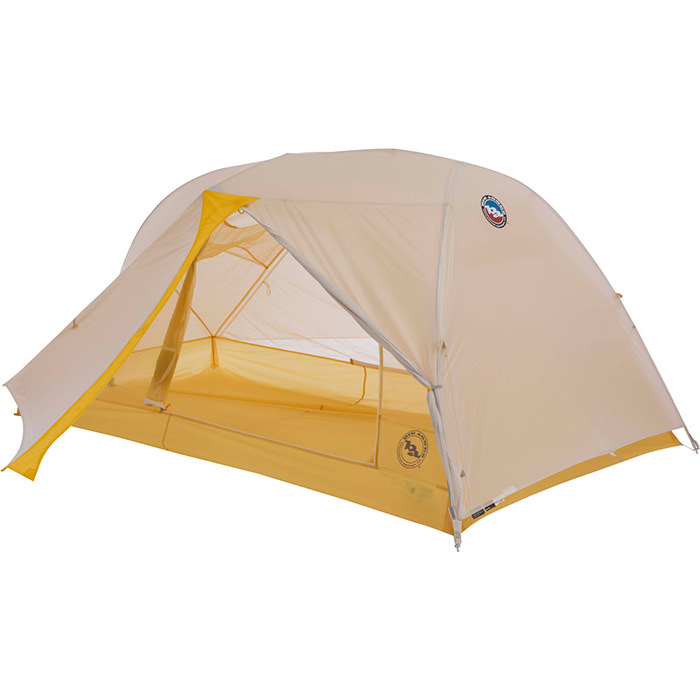
Big Agnes Tiger Wall 2 UL2 Solution Dye
Best Semi-Freestanding Tent
CleverHiker Rating: 79/100
Price: $450
Packed Weight: 2 lb. 8 oz.
Dimensions (LxWxH): 86 x 52/42 x 39 in.
Type: Semi-freestanding
Pros
- Ultralight
- Very useful pocket layout
- Quality construction/materials
- Roomy for one
- Two doors/vestibules (a perk for solo hikers)
Cons
- A bit tight for two
- Not as durable as some (floor material is thin)
- No rainfly vents
Solo backpackers who want some space to sprawl and ounce-counting pairs of hikers will love the ultralight design of the Big Agnes Tiger Wall 2. With enough structure to perform well in inclement weather but a weight that’s barely over a pound per person when split between two hikers, the semi-freestanding Tiger Wall is a more convenient alternative to non-freestanding ultralight tents.
The Tiger Wall 2 and Tiger Wall 3 are top picks for CleverHiker Managing Editor, Ben Applebaum-Bauch. He’s used the 2-person version on over 1,000 miles of trail – including the Oregon Coast Trail and Superior Hiking Trail – and the 3-person version for his 3,000-mile CDT thru-hike with his partner. Both sizes of the Tiger Wall held up beautifully on trail, and only have minor signs of wear and tear to show for all the hard miles put on them – very impressive for such lightweight shelters.
Semi-freestanding tents can often feel a bit cramped, but – while the quarters in the Tiger Wall 2 are still a bit tight for two – this tent has a wider ridge pole than most others in this category. The ridge pole creates more livable space where we want it most – at the head when sitting up. Additionally, you can save valuable floor space by storing gear in the large mezzanine pocket at the foot of the tent.
Another comfort feature of the Tiger Wall is the easy-to-use door toggles that give you the ability to roll back both sides of the vestibule to take in grand views or max out ventilation on clear nights. Since the Tiger Wall doesn’t have vents on the rainfly like many other tents, we prefer to sleep with one or both doors rolled back whenever possible for airflow.
Out of the three semi-freestanding tents on our list, this is the one we’d recommend most for pairs of hikers looking to balance weight and space most efficiently. Overall, hikers who prioritize saving weight and don’t mind sharing a tighter space will love the minimal yet functional design of the Tiger Wall 2. If you prefer more room to spread out, the excellent Tiger Wall 3 has extra floor space and a few more inches of peak height but is still lighter than many 2P tents.
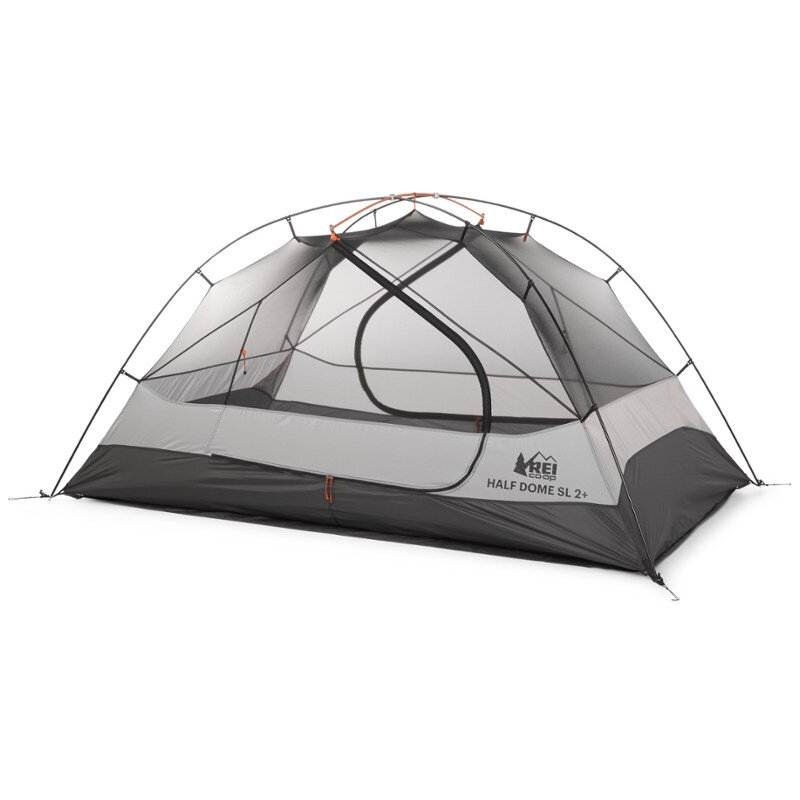
REI Half Dome SL 2+
Best Budget Tent for Backpacking & Car Camping
CleverHiker Rating: 79/100
Price: $349
Packed Weight: 4 lb. 11.5 oz.(including footprint)
Dimensions (LxWxH): 90 x 56 x 42 in.
Type: Freestanding
Pros
- Less expensive
- Very roomy interior
- More durable than many others
- Freestanding design is quick/easy to set up
- Footprint included
Cons
- Heavier than some
- Bulkier than some
REI’s Half Dome SL 2+ has an unrivaled blend of affordability, durability, and interior space. Its symmetrical freestanding design and very roomy dimensions make it comfortable and user-friendly for hikers of all experience levels. This is our favorite budget-friendly crossover tent for those who want a single shelter that works for camping in the frontcountry and the backcountry.
The spacious interior comfortably fits two hikers plus their gear – you could pack along two wide/long sleeping pads and still have room to spare. The generous amount of headroom also allows two campers to sit up comfortably which is a real perk on rainy days spent inside. While this isn’t the most glamorous camping tent nor the lightest backpacking tent, the Half Dome suits both needs well and costs far less money and storage space than buying a separate tent for each activity.
Though the weight of the Half Dome is more than we prefer for multi-day backpacking adventures, it’s not too bad when split between two hikers. In addition, you can save about 8 ounces by leaving the included footprint at home. Footprints aren’t strictly necessary and we often choose to hike without one. Just taking time to clear your campsite of debris before setting up will go a long way toward preserving your tent floor (but we wrote a whole post that’ll help you decide whether or not you should use a footprint). Plus the Half Dome already has a pretty robust floor as it is (40-denier nylon).
The NEMO Dagger 2 below is in this same crossover category, and – if money was no object – we’d recommend the Dagger over the Half Dome for its lower weight and larger amount of headroom. But budget is a top consideration for many of us when buying big-ticket outdoor gear, and the much friendlier price point of the Half Dome SL 2+ gets you a very comparable tent that won’t disappoint.
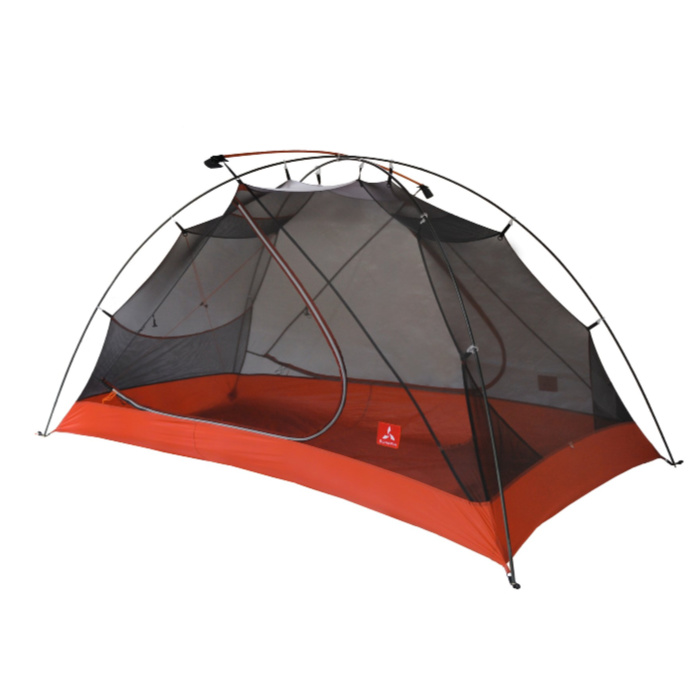
SlingFin Portal 2
Best Lightweight & Sturdy Tent for Harsh Conditions
CleverHiker Rating: 78.5/100
Price: $560
Packed Weight: 3 lb. 5 oz.
Dimensions (LxWxH): 85 x 51/42 x 44 in.
Type: Freestanding
Pros
- Excellent weather protection
- Lightweight
- Roomy interior
- Ample headroom
- Freestanding design is quick/easy to set up
- Useful pockets
- Large doors/vestibules
- Quality construction/materials
Cons
- Expensive
- Rainfly zippers can snag
With an extra stable frame, generous headroom, and top-quality construction and materials, the SlingFin Portal is an excellent lightweight shelter for hunkering down when nasty weather hits.
The Portal can be set up with internal guylines that run along the interior walls at the head and foot to give the structure significantly more strength in wind than external guylines alone. In the most basic terms, the internal guylines take the stress imposed on the structure by wind and transfer it to the stakes where your tent is anchored to the ground. This keeps the tent from bending and contorting in the wind like most other lightweight backpacking tents would. Comfort is increased as a result, but it also bumps safety up several notches since your poles will have a far lower chance of snapping in strong gusts.
Thicker poles, internal guylines, and the ability to attach trekking poles for added structural integrity make the Portal super solid in wind, rain, and even light snow. These features are unique for a lightweight backpacking tent and are generally more common in high-end 4-season mountaineering shelters. Many hikers would probably be better off buying the versatile Portal rather than a dedicated winter tent that’s heavier and less practical for summer and shoulder season hiking.
One of our favorite features of the Portal is its generous headroom, which makes it feel much more livable than the average lightweight 2-person backpacking tent. While we wish there was a smidge more floor space from head to foot on this tent, the solid amount of breathing room up top keeps the Portal from feeling cramped.
Other details like great pockets and included replacement zipper sliders come together with the stormworthy design to make the Portal one of the best backpacking tents we’ve ever tested for staying comfortable and safe in harsh weather.
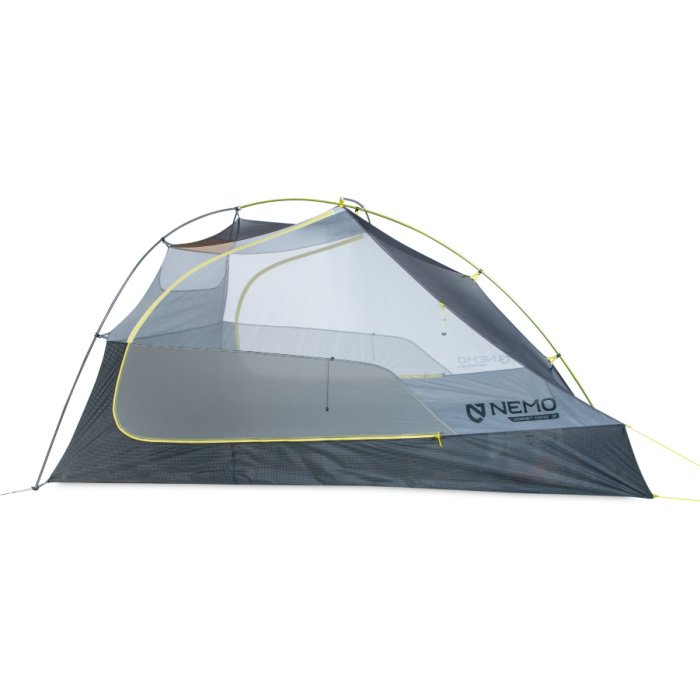
NEMO Hornet OSMO 3
Great Option for UL Hikers Wanting More Space
CleverHiker Rating: 78/100
Price: $550
Packed Weight: 3 lb. 5 oz.
Dimensions (LxWxH): 88 x 68/62 x 44 in.
Type: Semi-freestanding
Pros
- Ultralight for the size
- Well-priced for the specs
- Very roomy for two
- Convenient pockets
- High-quality materials/construction
- Good ventilation
- Innovative stuff sack makes it easy to split the load
Cons
- Expensive
- Rainfly zippers can snag
- Only one side of rainfly doors can be tied back
The sad reality is that many “two-person” backpacking tents feel tight and claustrophobic for average-sized hikers. If you want a little more room for gear storage, use 25-inch wide sleeping pads, or you just don’t always want to be pressed up against your tentmate, switching to a 3-person tent size can be a great choice. The key downside to choosing a larger tent is adding extra weight, which can bog you down on long backcountry trips.
That’s where a semi-freestanding tent like the NEMO Hornet OSMO 3 comes in. With the Hornet 3, a pair of hikers can have the convenience of a traditional 2-person tent – two large doors/vestibules, a very roomy interior, and many useful pockets – without the additional weight. And as a bonus, this spacious shelter costs around the same amount as many of the leading 2-person backpacking tents.
We’ve also been impressed with NEMO’s proprietary OSMO fabric in our testing. It repels water better than standard silnylon flysheets, stretches less when wet, and is also more durable. This means your tent pitch will stay tauter in the rain, you’ll have to make fewer adjustments in cold/wet weather, and overall your tent will last longer.
We’ve always been big fans of NEMO’s attention to detail, high-quality construction, and innovative designs, and the Hornet OSMO 3 doesn’t disappoint. It’s worth noting that NEMO also makes the Hornet in a popular 2-person model, but we prefer that design much more as a one-person shelter as it has significantly less headroom for two people.
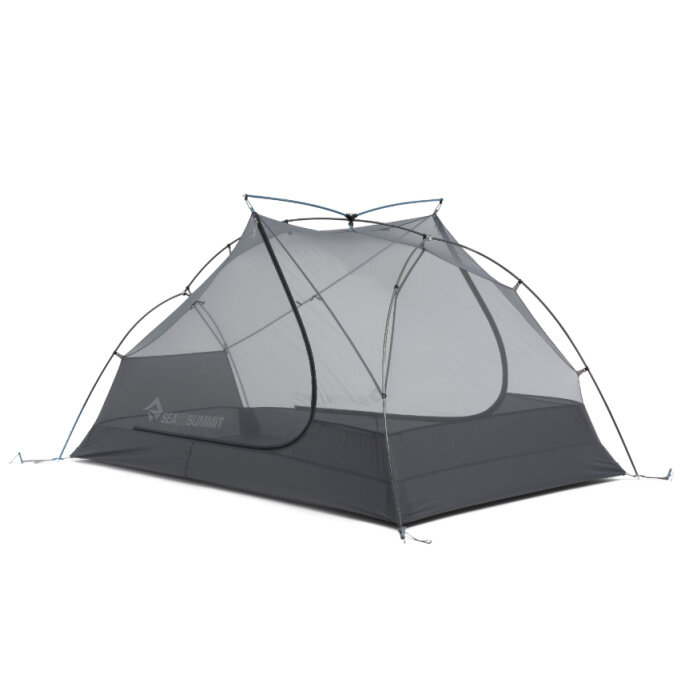
Sea to Summit Telos TR2
Exceptionally Spacious Backpacking Tent with Innovative Features
CleverHiker Rating: 78/100
Price: $449
Packed Weight: 3 lb. 10 oz.
Dimensions (LxWxH): 84.5 x 53 x 43 in.
Type: Freestanding
Pros
- Excellent headroom
- Quick/easy to set up
- Very light for the amount of space
- More comfortable living space than others
- Excellent ventilation
- Large doors/vestibules
Cons
- A bit heavier than some in this price range
- Unique stuff sacks not for everyone
The Sea to Summit Telos TR2 is an innovative tent with a lot of unique features to love. The biggest standout is its pole structure which provides far more headroom than any 2-person backpacking tent in its weight class.
The inverted ridge pole of the Telos points upward instead of sloping downward like most others. This creates tall door openings and practically vertical sidewalls that translate to a massive amount of headroom throughout the length of the tent. We find that having ample headroom inside a tent considerably increases comfort, and the Telos is certainly best-in-class for this spec.
CleverHiker Senior Gear Analyst, Casey Handley, took the Telos on a rainy test hike over the 40-mile Timberline Trail with her partner. This spacious tent provided a cozy retreat for the pair to wait out inclement weather when the rain really started coming down. There was plenty of room to keep gear dry inside as well as enjoy a game of cards until the weather quieted down.
The Telos also has exceptional ventilation – it features a huge apex vent that can be opened or closed plus low venting on the vestibules that can be deployed when necessary. We find that the vents create truly excellent circulation and provide comfortable and practically condensation-free nights. Other creature comforts, like the light-dispersing Lightbar and shady Hangout Mode, add to its livability and make the Telos feel like a little slice of luxury in the backcountry.
Though it’s a little spendy, the comfort the Telos provides is worth the cost if you’re looking for a versatile 2-person backpacking tent with all of the details dialed in. There’s really nothing else on the market like this tent, and we recommend it to hikers whose main priority is comfort on trail.
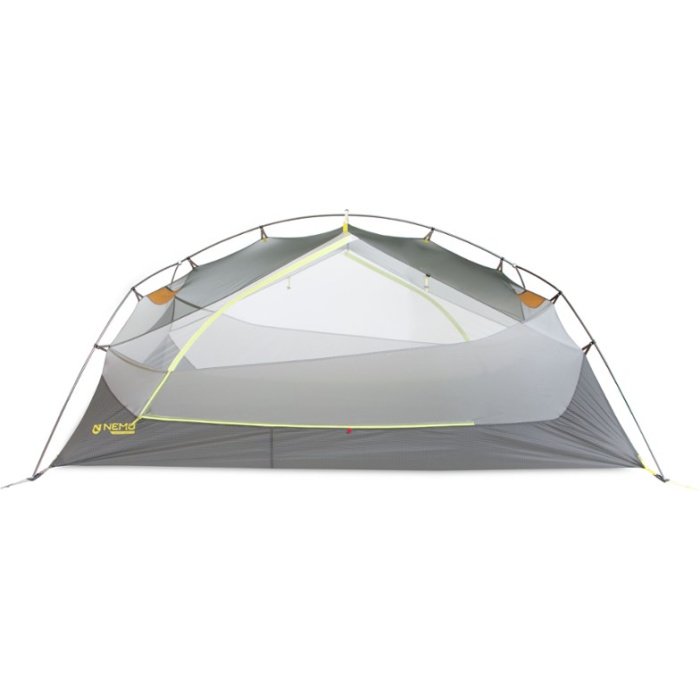
NEMO Dagger OSMO 2
Best Crossover Tent for Backpacking & Car Camping
CleverHiker Rating: 76/100
Price: $530
Packed Weight: 4 lb. 2 oz.
Dimensions (LxWxH): 90 x 50 x 42 in.
Type: Freestanding
Pros
- Very spacious
- Freestanding design is quick/easy to set up
- Light for how much space it offers
- Durable
- High-quality materials/construction
- Large doors/vestibules
- Great pockets
Cons
- On the heavy side
- Expensive
The NEMO Dagger OSMO 2 offers a ton of interior space at a reasonable weight, so it’s perfect for those wanting a tent that’s comfortable for both backpacking and car camping.
When split between two hikers, each will carry just over two pounds. While that’s not as impressive as some others at first glance, it’s actually very respectable when you consider the whole picture. The Dagger offers significantly more interior space than much of the lighter weight competition thanks to its long, rectangular floor and nearly vertical side walls.
Since the Dagger has enough floor space for two wide/long pads and plenty of interior volume to comfortably hang out inside, it works quite nicely for car camping as well. Crossover tents like this one will save the user storage space at home and a ton of money over buying a dedicated tent for each activity.
The Dagger has many convenient features built in, like two huge, trapezoidal vestibules for gear storage, light-dispersing headlamp pockets, and an included tub accessory for the vestibule that keeps your gear clean and dry. The innovative OSMO fabric also doesn’t sag when wet (unlike Silnylon), and it remains waterproof for longer than the coated fabrics used for many other tents.
Though the Dagger is among the more expensive tents on our list, its ability to pull double-duty as a luxurious backpacking tent or a comfortable car-camping tent makes it a versatile option that’s worth the high price tag. Those looking for lightweight livability in a convenient design will find that the NEMO Dagger OSMO 2 is among the best of the best.
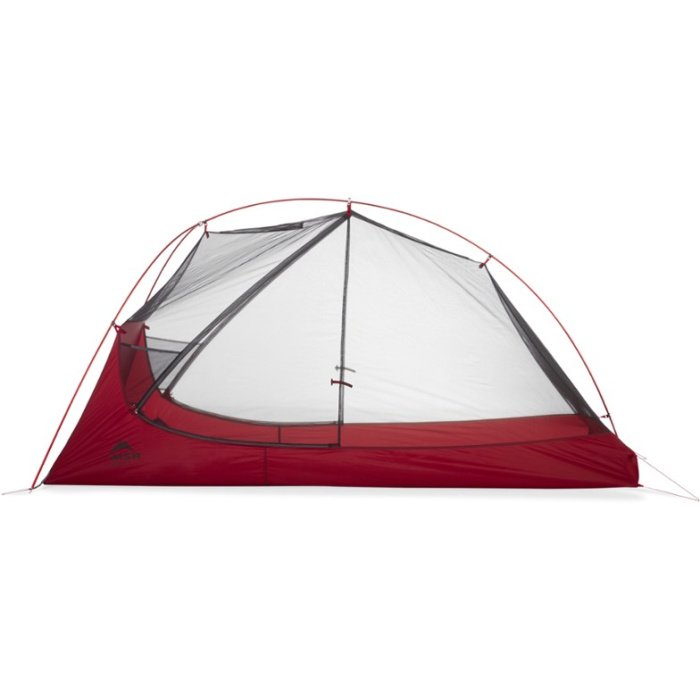
MSR FreeLite 2
Good Balance of Weight & Livability for Solo Hikers
CleverHiker Rating: 74/100
Price: $450
Packed Weight: 2 lb. 5 oz.
Dimensions (LxWxH): 84 x 50 x 39 in.
Type: Semi-freestanding
Pros
- Ultralight
- Roomy for one
- Two doors/vestibules (a perk for solo hikers)
- Convenient pockets
- Rainfly gutter prevents drippy entry
Cons
- Tight for two
The MSR FreeLite 2 is a great option for those looking to go lighter without sacrificing the convenience of a double-wall tent. It has two large doors/vestibules, a smart rainfly design that prevents drippy entry in the rain, and a lower weight than many similarly designed tents.
We view the FreeLite as more comfortable for solo hikers since the interior headroom can feel a little cramped when spending any extended amount of time inside. But for pairs that value saving weight over having more interior space, the FreeLite has the dimensions to accommodate two people.
The rainbow shape of the FreeLite is effective at shedding precipitation, and the unique rainfly gutters direct water away from the zippered entry to prevent it from pooling up and pouring onto the floor while moving in or out of the tent in wet weather.
Solo backpackers wanting the best mix of weight, livability, and weather protection will love the FreeLite, and pairs who would opt to save weight and don’t mind tight quarters will find that this tent delivers excellent performance.
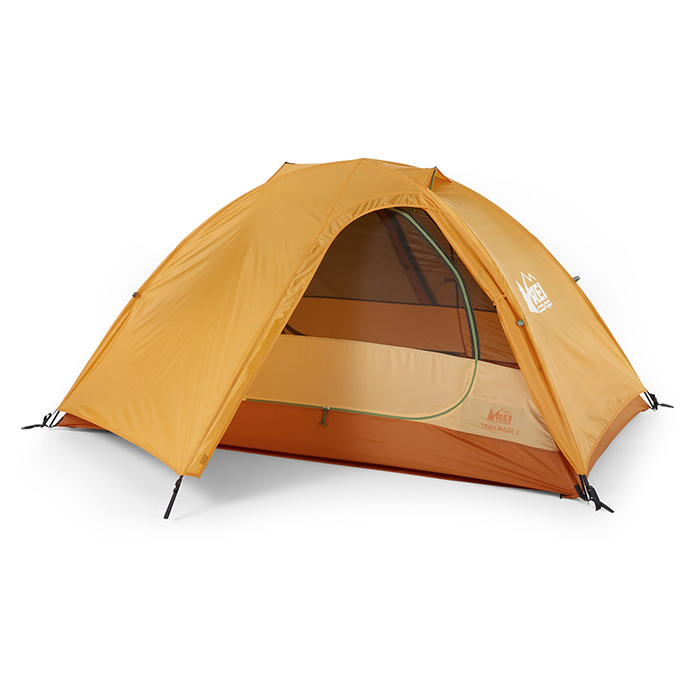
REI Trailmade 2
Most Affordable Crossover Tent for Backpacking & Car Camping
CleverHiker Rating: 73.5/100
Price: $199
Packed Weight: 5 lb. 7 oz.(including footprint)
Dimensions (LxWxH): 88 x 52 x 40 in.
Type: Freestanding
Pros
- Affordable
- Durable (strong zippers & thick material)
- Freestanding design is quick/easy to set up
- Large doors/vestibules
- Footprint included
Cons
- Heavy
- Bulky
- Lack of ridge pole limits headroom a bit
The affordable REI Trailmade 2 is a great tent for backpackers on a tight budget or those wanting to save money on a crossover tent that works for both car camping and backpacking.
Though none of the Trailmade’s specs (other than price) are really standouts, the tried-and-true dome design holds up well in bad weather. The quality materials and construction of the Trailmade (strong zippers and thicker material) ensure this tent will remain reliable through many seasons of use. And the symmetrical free-standing design is quick and easy to pitch, so this is a great starter tent for beginners.
What holds the Trailmade back from ranking higher on our list is the lack of a ridge pole across the top. Most backpacking tents nowadays include this pole to pull out the sides of the tent and increase headroom – significantly increasing livability without much added weight. Since the Trailmade omits this pole, it feels a bit narrow inside across the spine – especially when the space is split between two hikers.
While we consider the Trailmade a bit heavy for backpacking, the weight and bulk aren’t too bad when split between two hikers. You can also save about 8 ounces by leaving the included footprint at home.
The budget-friendly Trailmade is an excellent investment for beginners and those wanting to get into the backcountry without spending a fortune. We would recommend trying to stretch your budget a bit for one of the more comfortable options on this list if you plan to backpack often, but you won’t be disappointed by the Trailmade if you really just need to keep costs down.
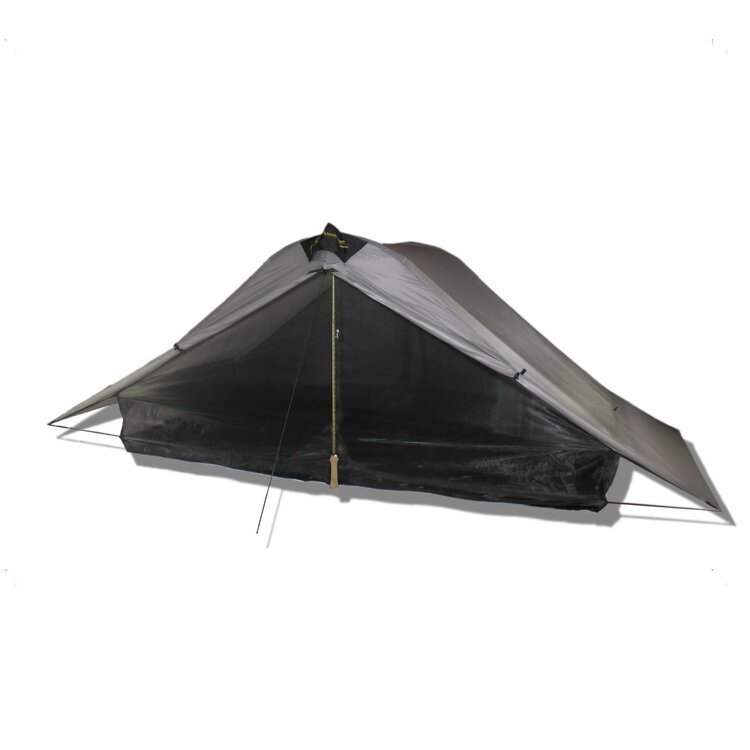
Six Moon Designs Lunar Duo
Affordable & Spacious Ultralight Backpacking Tent
CleverHiker Rating: 73.5/100
Price: $395
Packed Weight: 2 lb. 13 oz.(no stakes or poles)
Dimensions (LxWxH): 90 x 54 x 45 in.
Type: Non-freestanding
Pros
- Spacious
- Affordable
- Ultralight
- Small packed size
- Very durable for the weight
- Ample headroom
- Excellent ventilation
- Large doors/vestibules
Cons
- Seam sealing costs extra
- Needs condensation management
- Non-freestanding design has a learning curve
The Six Moon Designs Lunar Duo is one of the best value backpacking tents on our list due to its excellent blend of space, weight, and durability. CleverHiker Gear Tester, Heather Eldridge, has put the Lunar Duo through the wringer on multiple thru-hikes covering thousands of miles, and it continues to hold up like a champ.
The Lunar Duo is a bit heavier than many other ultralight non-freestanding tents, like the Zpacks Duplex above, but we find the weight tradeoff is worth the significant monetary savings for hikers on a budget. One thing that makes the Lunar Duo unique among non-freestanding tents is the arched brow poles over the doors. These poles maximize headroom along the entire length of the tent and give the Lunar Duo the most luxuriously spacious interior of any model in its class.
The large vestibules are designed to open completely without disturbing the structure of the tent so you get the same ventilation and view benefits as a double-wall tent. On top of that, the floating canopy and peak vents work together to create ample airflow in the Lunar Duo – cutting down significantly on interior condensation.
If you’re looking for a roomy ultralight shelter at an exceptionally affordable price, few tents come close to the Lunar Duo.
Solo hikers wanting to cut down on weight even more, should check out the Lunar Solo. It’s one of our top 1-person tent picks because it’s very spacious for one hiker and their gear, it’s easy to set up, and it’s incredibly affordable for the specs.
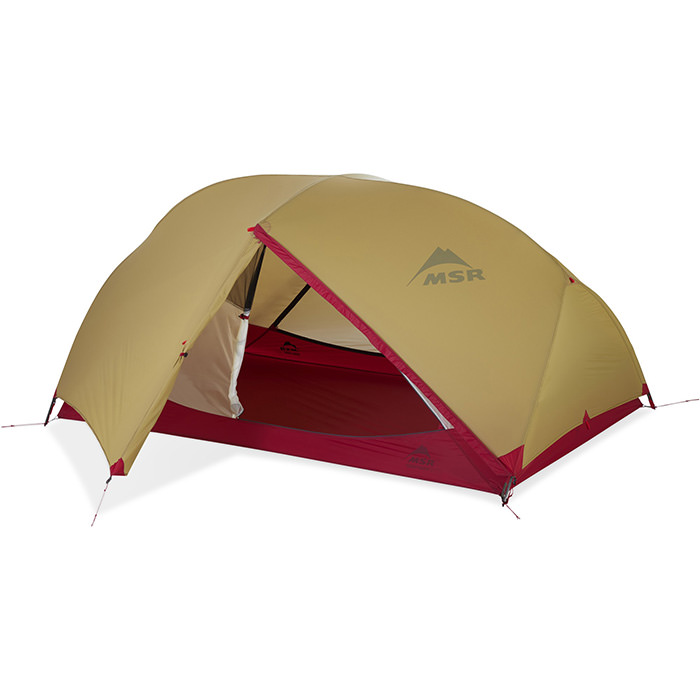
MSR Hubba Hubba 2
Great Balance of Weather Protection & Weight
CleverHiker Rating: 71.3/100
Price: $550
Packed Weight: 3 lb. 4 oz.
Dimensions (LxWxH): 84 x 50 x 40 in.
Type: Freestanding
Pros
- Great weather protection
- Freestanding design is quick/easy to set up
- Durable
- Lightweight for the weather-worthiness
- Great pockets
Cons
- Lack of headroom makes interior feel a bit tight
- Expensive
The long-time crowd favorite MSR Hubba Hubba 2 is a standout on the backpacking tent market for its durability and weather protection. The rainbow shape of this tent leaves very little surface area along the spine to catch gusts of wind, and there aren’t any flat surfaces on the fly for water to pool.
One of our favorite details of the Hubba Hubba is the gutter on the vestibule doors. This little feature directs water down a groove behind the rainfly closure providing a drip-free entry in wet weather.
The Hubba Hubba’s symmetrical freestanding design makes it quick and easy to set up and provides just enough space to squeeze two wide pads inside. However, we find that the pole structure causes the walls to slope inward – limiting interior headroom.
That said, if you tend to be hard on gear or you often backpack in places with temperamental weather, the Hubba Hubba is still a top choice for its high-quality build at a relatively low weight.
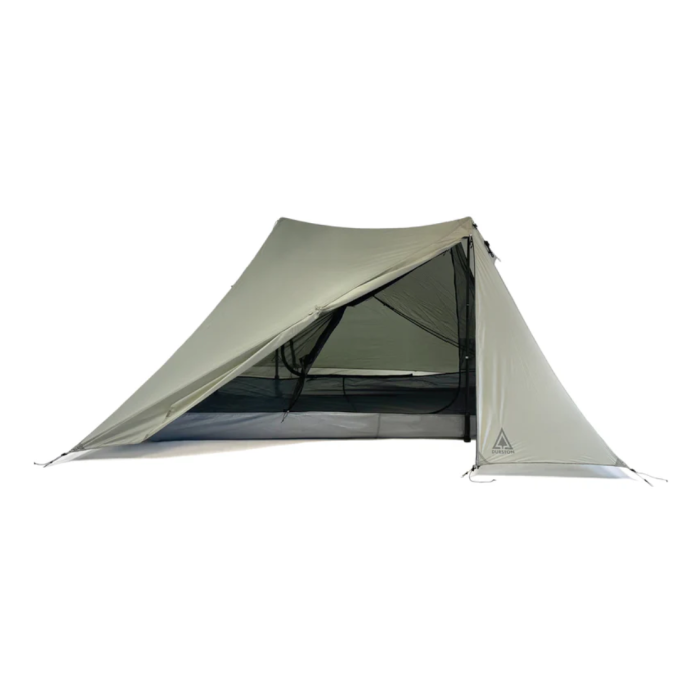
Durston X-Mid 2
Best Affordable Ultralight Backpacking Tent for One Person
CleverHiker Rating: 69.5/100
Price: $280
Packed Weight: 2 lb. 2.1 oz.(no stakes or poles)
Dimensions (LxWxH): 92 x 52 x 48 in.
Type: Non-freestanding
Pros
- Ultralight
- Excellent ventilation
- Easy to pack
- Excellent Protection in wet weather
- Excellent vestibule design
- Spacious interior
- High pockets creat less sag
- Affordable
Cons
- Interior shape makes usable space less convenient
- Shape makes it tough to get a perfect pitch
- Large footprint & non-freestanding design can make campsite selection difficult
- 90-degree zippers aren't the most user-friendly
The Durston X-Mid 2 is a nice non-freestanding shelter for one person. We appreciate the near-vertical side walls, which create a roomy interior at shoulder height for comfortable sitting and changing. The interior pockets are situated higher up in the canopy than most other tents. Though it’s a slightly longer reach, it does prevent the walls from sagging in when there’s a heavy object tucked away. The footprint is also a rhombus which creates extra space to store gear at the head and foot.
We’ve weathered dozens of storms in the X-Mid and it has proven to be durable in the long run. Its 20D polyester fabric and robust zippers withstand the rigors of backcountry travel and the two vents at the top with kickstands do a solid job of releasing condensation. This tent has saved us more than once in rainstorms because the inner portion can be pitched after the fly has been set up, keeping the inside dry. This fly-first design also makes it possible to leave the tent at home if you are inclined to go ultra-ultralight.
One of the biggest drawbacks of this model is that it is challenging to set up on uneven ground. It’s also not as stable as dedicated-pole freestanding models. However, its low-profile maximizes wind resistance, and the fully seam-taped bathtub floor and double-wall construction keep moisture out.
Weighing in at just over two pounds, the X-Mid is a featherweight champion in the world of backpacking shelters. Its minimalist design and efficient use of lightweight materials make it a top choice for ounce-counting thru-hikers and ultralight enthusiasts. Though its pitched footprint is arguably too large for tighter campsites, its compact packed size, it easily fits into the crevices of a pack. We also don’t love the offset geometry of the interior for two people – one person gets a nice high ceiling and the other gets a face full of tent.
The 90-degree zippers are not the most user-friendly, but this shelter is a lightweight, roomy and cost-effective option for one person.
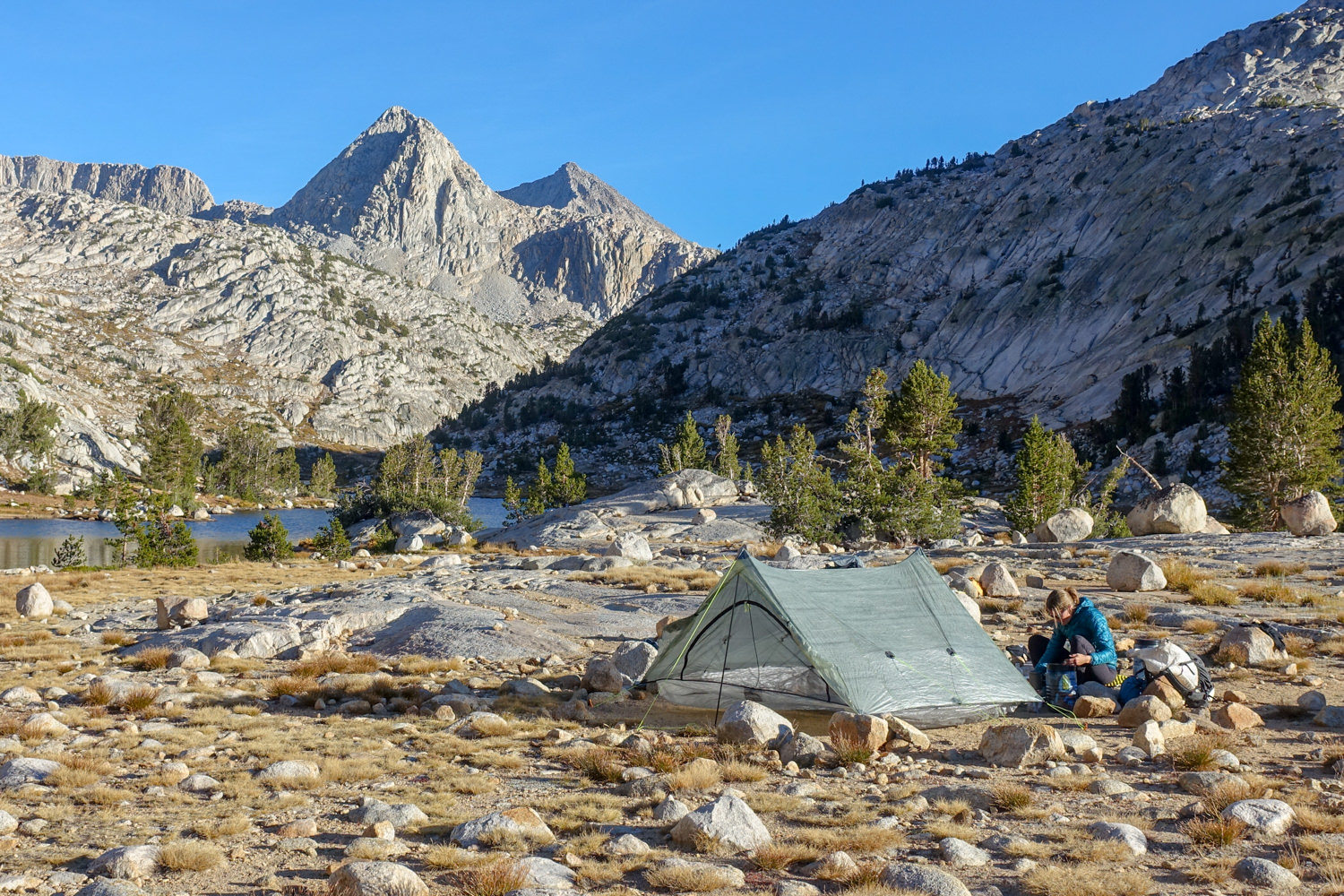
Product Comparison Table
| oSort | Product | Price | Packed Weight | Dimensions (LxWxH) | Type | Comfort | Weight | Weather Resistance | Ease of Setup | Durability | 0 |
Big Agnes Copper Spur HV UL2 View at REI View at Amazon |
$530 | 3 lb. 2 oz. | 88 x 52/42 x 40 in. | Freestanding | 8 | 8 | 8 | 8.5 | 7.5 | 1 |
Zpacks Duplex Classic View at Zpacks |
$699 | 1 lb. 1.9 oz. (no stakes or poles) | 90 x 45 x 48 in. | Non-freestanding | 7.5 | 10 | 8 | 6 | 7.5 | 2 |
Big Agnes Tiger Wall 2 UL2 Solution Dye View at REI View at Amazon |
$450 | 2 lb. 8 oz. | 86 x 52/42 x 39 in. | Semi-freestanding | 7.5 | 9.5 | 7.5 | 7.5 | 6.5 | 3 |
REI Half Dome SL 2+ View at REI |
$349 | 4 lb. 11.5 oz. (including footprint) | 90 x 56 x 42 in. | Freestanding | 9 | 5 | 8.5 | 9 | 9 | 4 |
SlingFin Portal 2 View at SlingFin |
$560 | 3 lb. 5 oz. | 85 x 51/42 x 44 in. | Freestanding | 8 | 7 | 8.5 | 8 | 8 | 5 |
NEMO Hornet OSMO 3 View at REI View at Amazon |
$550 | 3 lb. 5 oz. | 88 x 68/62 x 44 in. | Semi-freestanding | 9 | 7.5 | 7 | 7.5 | 7 | 6 |
Sea to Summit Telos TR2 View at REI View at Sea to Summit |
$449 | 3 lb. 10 oz. | 84.5 x 53 x 43 in. | Freestanding | 8.5 | 6.5 | 8 | 8.5 | 7.5 | 7 |
NEMO Dagger OSMO 2 View at REI View at Amazon |
$530 | 4 lb. 2 oz. | 90 x 50 x 42 in. | Freestanding | 8.5 | 5.5 | 8 | 8.5 | 8 | 8 |
MSR FreeLite 2 View at MSR View at Amazon |
$450 | 2 lb. 5 oz. | 84 x 50 x 39 in. | Semi-freestanding | 6 | 9.5 | 7 | 7.5 | 7 | 9 |
REI Trailmade 2 View at REI |
$199 | 5 lb. 7 oz. (including footprint) | 88 x 52 x 40 in. | Freestanding | 7.5 | 4.5 | 8.5 | 9.5 | 8.5 | 10 |
Six Moon Designs Lunar Duo View at Six Moon View at Amazon |
$395 | 2 lb. 13 oz. (no stakes or poles) | 90 x 54 x 45 in. | Non-freestanding | 8.5 | 8 | 6.5 | 6 | 6 | 11 |
MSR Hubba Hubba 2 View at REI View at Amazon |
$550 | 3 lb. 4 oz. | 84 x 50 x 40 in. | Freestanding | 6 | 7 | 8 | 8.5 | 7 | 12 |
Durston X-Mid 2 View at Durston |
$280 | 2 lb. 2.1 oz. (no stakes or poles) | 92 x 52 x 48 in. | Non-freestanding | 7 | 8 | 6.5 | 5.5 | 6 |
|---|
How We Test & Methodology
We assessed each backpacking tent based on five criteria: comfort, weight and packability, weather resistance, ease of setup, and durability. We have spent a minimum of 20 nights (but in some cases, over 100) in each of these models in a range of hiking conditions, from the hot, dry deserts of the southwest to the coldest, wettest reaches of northern New England.
COMFORT
Comfort spans a wide range of characteristics. We pay careful attention to things like floor dimensions, including maximum dimensions and any head-to-foot taper; peak height (as well as interior volume and shoulder space); number and style of doors; zipper pulls and door tie-backs; number, size, and placement of storage pockets; and any special features that make the experience of living in the tent more enjoyable. We get an extremely good sense of each of these characteristics by sleeping, eating, and living side-by-side with our hiking partners.
WEIGHT & PACKED SIZE
Manufacturers often list multiple weights, which include different combinations of tent components. We consider the packaged weight – the tent body, fly, poles, and included stakes) – as well as the packed size of each model, testing out how easy it is to stuff each one into a pack and around other gear, noting any especially streamlined or chunky hardware that takes up space.
WEATHER RESISTANCE
We look at weather resistance inside and out. Our assessment includes the rain, hail, and snow resistance of the fly, including both water penetration/dripping through the fly, as well as splashback from underneath the fly, and any sagging from saturation. In addition to precipitation, we consider the wind resistance which entails assessing the quality and stability of stakes; number and location of guypoints; and vestibule geometry. Lastly, we analyze interior condensation, paying attention to the number, size, and location of vent points, as well as, obviously, the amount of moisture on the underside of the fly when we wake up each morning.
EASE OF SETUP
Most of these tents are fairly easy to set up but some go a little faster than others. Here, we measure how long it takes on average to set up each model. The differences come down to whether or not the tent is symmetrical (thus providing two correct orientations for a tent and fly instead of just one); the pole-to-tent connection system; the fly-to-tent connection system; the quality and bite of the included stakes, as well as whether or not there are enough of them; and any tensioning systems that make it easier to get a good taut pitch.
DURABILITY
Durability includes both on trail wear and tear as well as longevity season after season. We set up each model on a variety of surfaces, from soft soil to sandy, gravely clearings. Pinholes in the floor, micro-fissures at the ends of poles, and zipper snags are all top-of-mind. In addition, our experience has taught us that certain materials and waterproof coatings are more resilient than others so we assess fabric type, thickness, and chemical treatments, also noting if a model provides a repair kit (e.g. pole sleeve or adhesive patches) for fixes in the field.
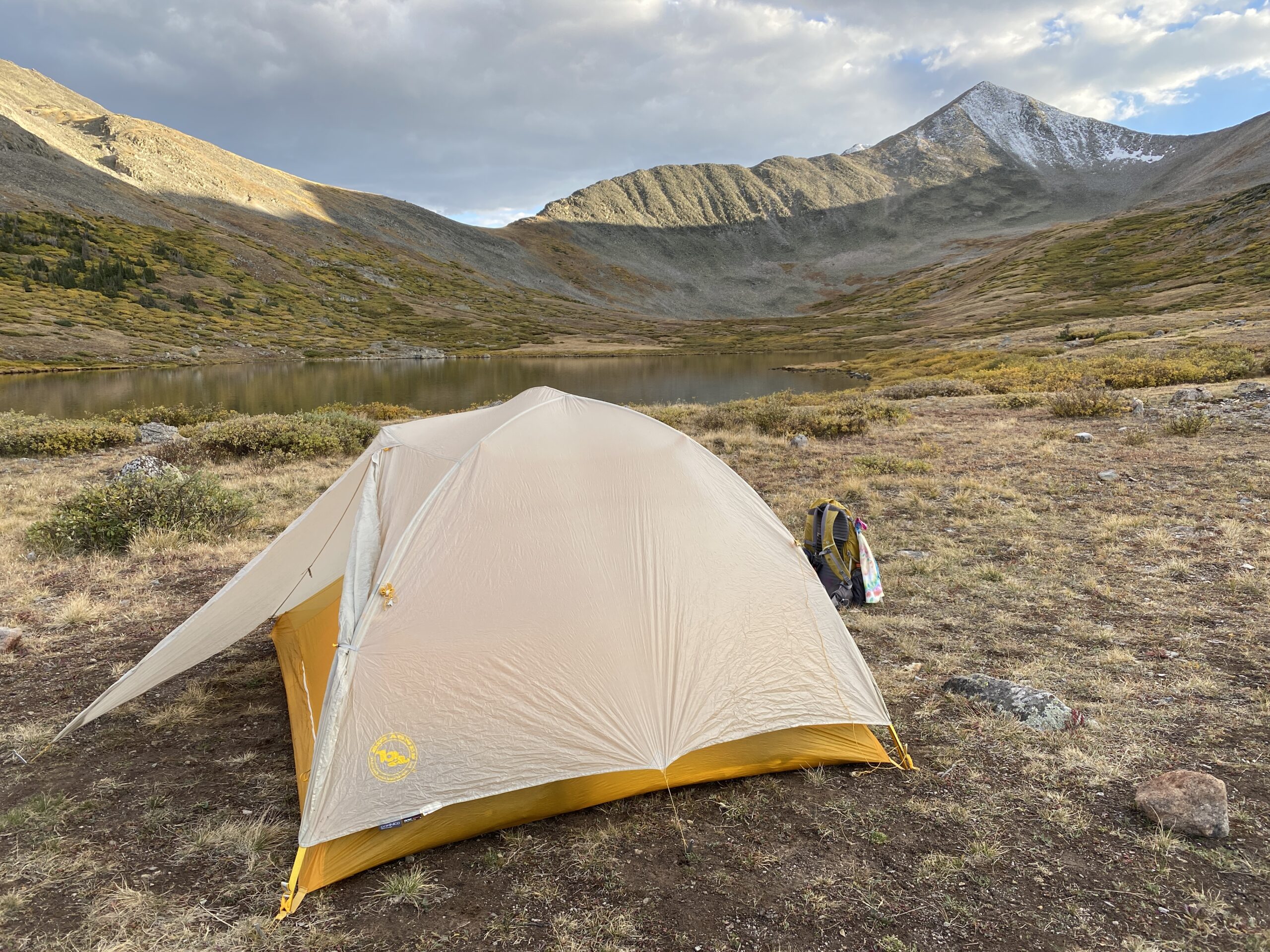
Why Trust CleverHiker
We’ve spent over 1,000 nights in these backpacking tents and covered over 20,000 miles with them on our backs. Senior Gear Analyst and lead tester, Casey Handley, has pitched and slept in these shelters along her many thru-hikes of the Arizona Trail, Appalachian Trail, Colorado Trail, Long Trail, and more. She has weathered nights through high-alpine storms in frigid temperatures on trail and poured over all of the specs at basecamp. Her previous experience at REI also gives her unique data-driven insight into the features and functionality that backpackers, including herself, are most often looking for.
Analysis & Results
We rank tents based on five different metrics including comfort, weight and packed size, weather resistance, ease of setup, and durability. Our comparative results below outline the top performers in each metric.
VALUE
Good, lightweight backpacking tents are expensive, but that doesn’t mean some of them aren’t a great value. When we do our testing, we are careful to note products that outperform what they cost. This could mean both low-priced items that get the job done just as well if not better than the more expensive competition, as well as pricier tents that are just smashing it out of the park.
The REI Half Dome SL 2+ is one of the highest-value backpacking tents around. Its spacious floor dimensions and headroom make it one of the more comfortable options while also logging reliable weather resistance and sporting thick, durable fabrics. The REI Trailmade 2 is on the heavier side, but the price is right and it’s super easy to set up.
Overall top performers like the Big Agnes Copper Spur HV UL2 and Big Agnes Tiger Wall Solution Dye are pricier for sure but their combination of light weight and space makes them some of the best options available for longer treks.
COMFORT
The REI Half Dome SL 2+ has comfort features that make it a great option for two people who want to spread out on a long weekend adventure. Its generous 56-inch width means that you don’t have to worry about rubbing shoulders with your hiking partner if you both want to sit up at the same time. The impressive peak height and large double doors also add to the livability of this model.
Not far behind, the NEMO Hornet OSMO 3 is another great option for the space-needy backpacker. Though it tapers from head to foot, it is wide enough all around that two people will have plenty of space. Its white mesh is also a nice feature that adds a little bit of privacy at camp, even if the fly is off or tied back, and the large storage pocket at the head means that you can store even large items off the floor but keep them close at hand.
In the next tier, the SlingFin Portal 2, NEMO Dagger OSMO 2, Sea to Summit Telos TR2, and Six Moon Designs Lunar Duo all have their unique redeeming comfort features that make them stand out. Though the Slingfin doesn’t have exceptional length, it does have an especially high peak height for its weight and size. The two curved side doors are easy to open and close and there are plenty of storage pockets all around for small items. Though the Dagger OSMO 2 has two zippers on each door, which makes it a little clunkier to open, it has larger dimension than the Portal and the extra length is much appreciated for taller sleepers. The Telos TR2 is a little clunkier to enter and exit, but its unique tension ridge pole across. the top creates tons of space at shoulder height for sitting up and playing cards with your hiking partner. And though the Lunar Duo is non-freestanding, it has massive dimensions relative to its weight.
WEIGHT & PACKED SIZE
With no stakes or poles, the Zpacks Duplex Classic takes the top spot in this metric. Since it’s non-freestanding, it uses a standard pair of trekking poles that you are likely already carrying to create the structure it requires to pitch. (And even including the weight of a pair of typical poles, it is still a lighter package than almost all of the freestanding tents). The two other non-freestanding options – the Six Moon Designs Lunar Duo and Durston X-Mid – are both quite a bit heavier (though much less expensive), but are still a very comfortable two-ish pounds.
The Big Agnes Tiger Wall Solution Dye makes this list precisely because it is the best balance between the comfort and structure of a double-wall tent while weighing in at a scant two and a half pounds. For there size, the Big Agnes Copper Spur HV UL2 and NEMO Hornet OSMO 3 are both exceptionally light and are well worth the investment for those who want the best of both worlds.
WEATHER RESISTANCE
The SlingFin Portal 2 is designed for inclement weather. We love the guylines inside the tent that let us tension it properly for added wind resistance. It also comes with ample stakes and additional external guylines. The fly runs low to the ground and the kickstand vents at the doors are reasonably effective at dispersing condensation.
The REI Half Dome SL 2+ also has effective fly vents. It earns its stripes in this metric for its high bathtub floor, which limits splashback in heavy rain, and its 30D fly and large vestibules, which keep gear protected. Though its more basic pole structure makes it slightly less stable than the Half Dome, the REI Trailmade 2 otherwise benefits from the same features.
The NEMO Dagger OSMO 2 has a unique trapezoidal vestibule geometry that significantly limits how much it can flap in the wind and also increases the usable storage pace. Though the higher cut at the ends of the fly leaves the main tent body exposed a little more than other models, we never experienced problematic seepage. The proprietary fabric also sags less than its other nylon counterparts, which is a huge upgrade.
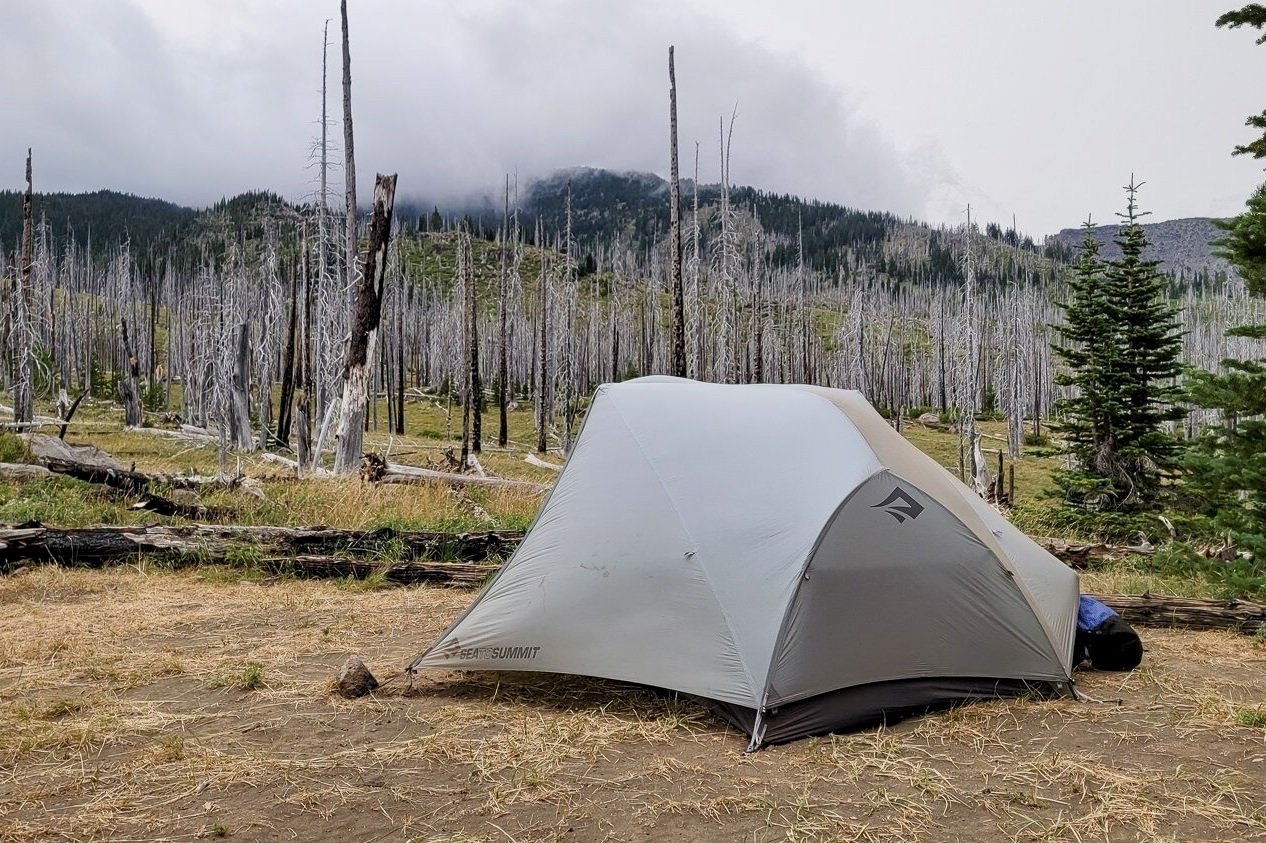
EASE OF SETUP
Most freestanding tents are pretty straightforward to pitch. This is especially true for the REI Trailmade 2. It has a very basic X-pole design, with two long poles that cross at the apex and secure easily into grommets at the corners. The fly attaches with buckles at the corners and because it’s symmetrical, it doesn’t require any color coding – it goes on correctly multiple ways as long as you have the doors lined up. The REI Half Dome SL 2+ is similar – the primary difference is that it has a long brow pole and is slightly larger so it takes just a fraction longer to setup.
The hubbed pole designs of the Slingfin Portal 2, NEMO Dagger OSMO 2, and Sea to Summit Telos TR2 make it a breeze to shake the pole segments into place in a matter of seconds. We also appreciate the color-coded poles and segments of the Dagger OSMO 2 and Big Agnes Copper Spur HV UL2, which makes it easy to orient everything correctly.
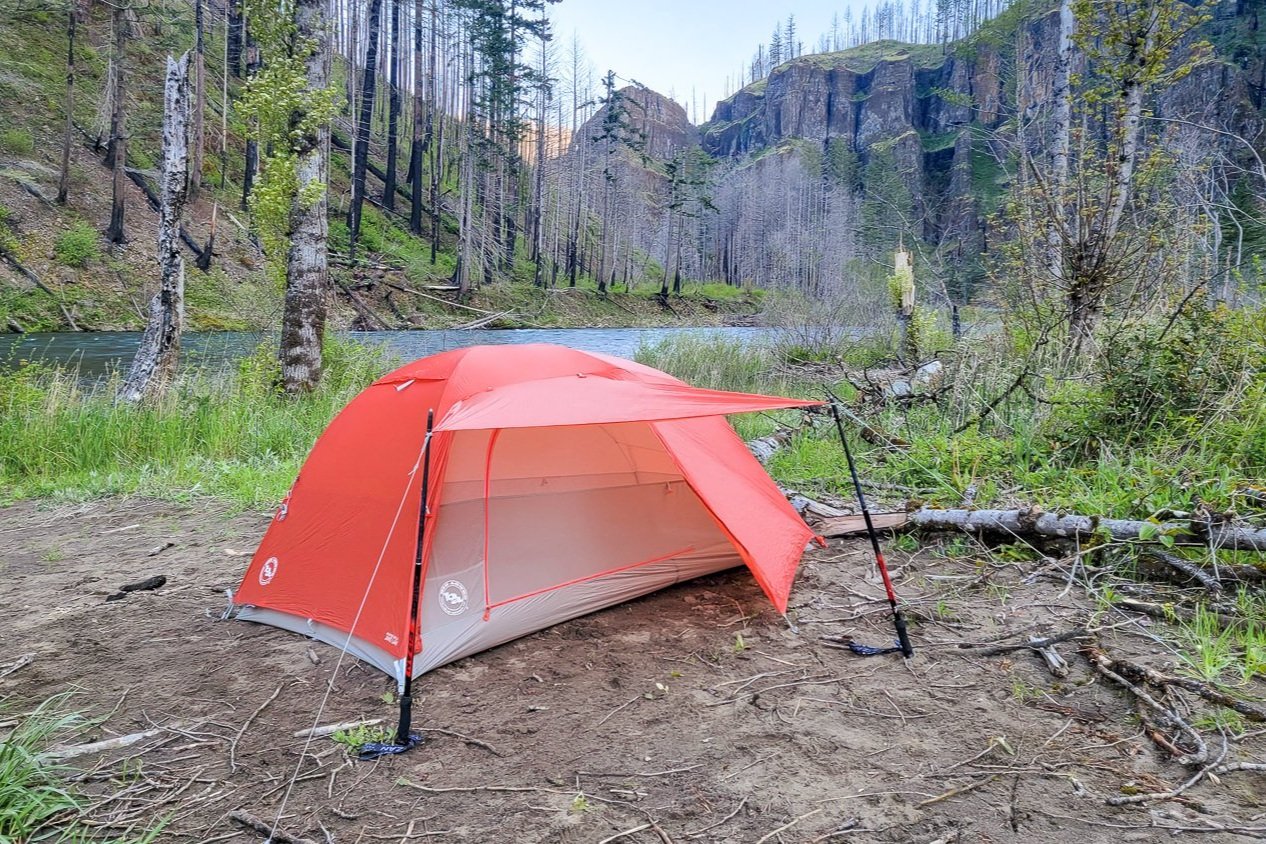
DURABILITY
The burly fabric of the REI Half Dome SL 2+ makes it stand out among the competition for its durability. The 40D ripstop nylon floor stands up to rough ground and it comes with a footprint for even more protection. The pre-bent poles also help reduce the tension in key segments so they are less likely to crack.
The Slingfin Portal 2 has thinner 20D ripstop nylon floor fabric but one longevity feature we love is the pre-installed backup zippers on the tent door. This common failure point often renders an otherwise good tent much less practical but the extra set of pulls provides peace of mind.
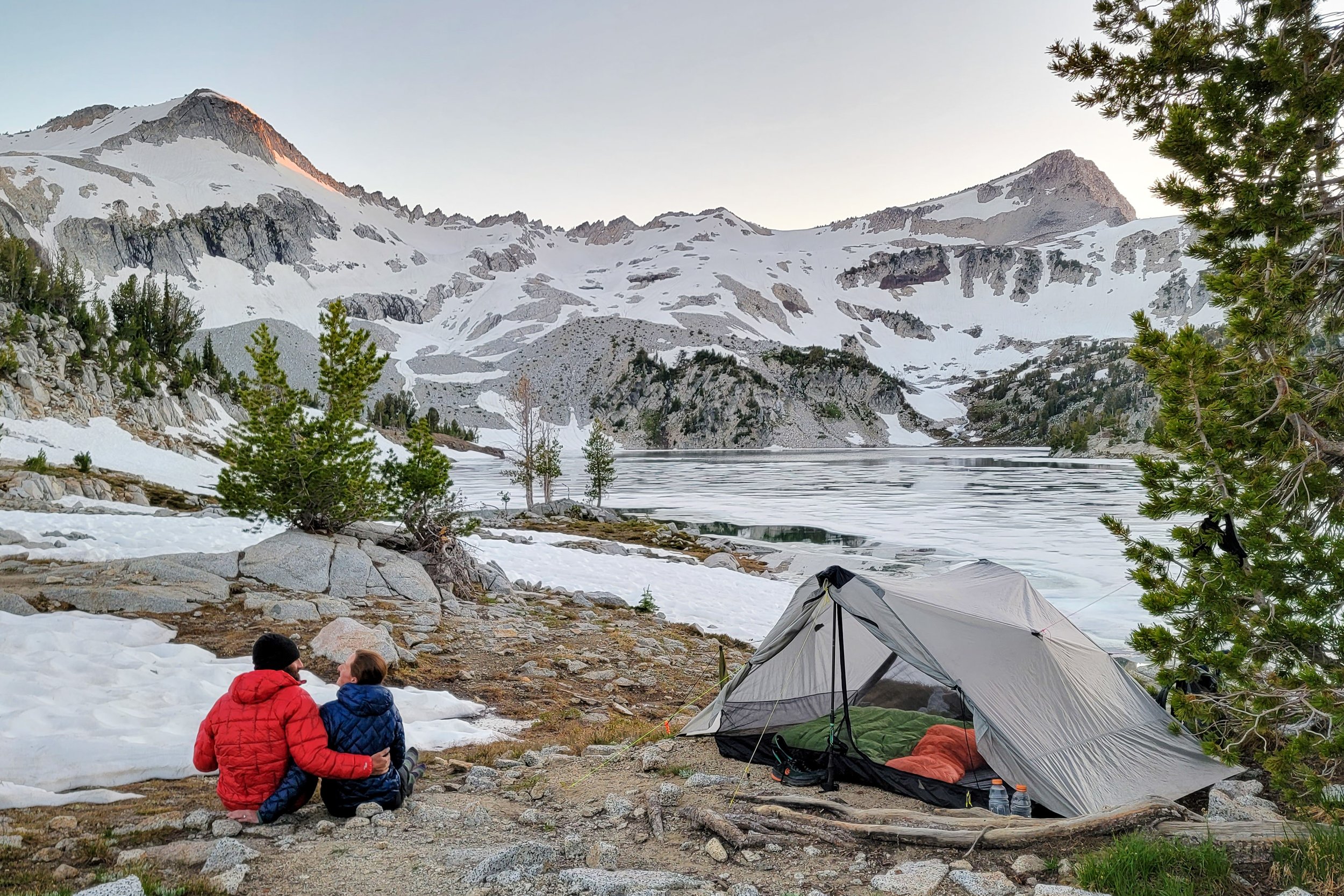
How to Choose a Backpacking Tent
PRICE
You shouldn’t have to spend a fortune to get a great backpacking tent. That’s why this list contains an array of solid options at a variety of price points. If you backpack a lot, it probably makes sense to spend more for a quality product that will get many years of use. If you’re on a limited budget, you may want to check out our budget backpacking tent recommendations, but they do tend to be much heavier.
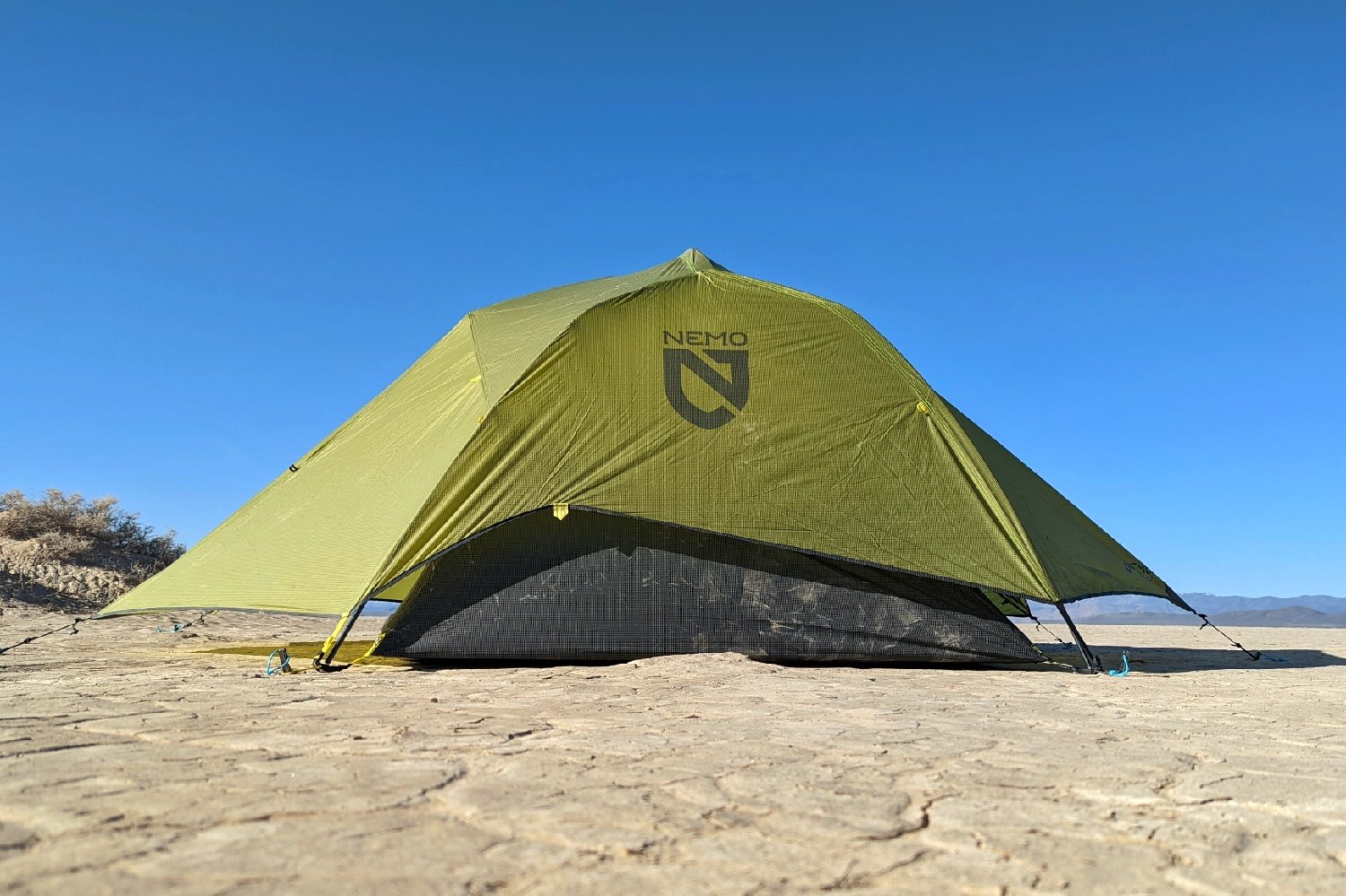
CHOOSING A SIZE
The reality with tent sizes is that a lot of manufacturers exaggerate how many people can sleep comfortably in them. For example, many two-person backpacking tents are a tight fit for two average-sized people. If you plan on sleeping two people in your tent and want more space, you may find a three-person tent to be more comfortable. Extra space will add weight, so you’ll probably want to choose a lightweight tent to keep your backpack light. Check out our Tent Size Guide for more info on finding the right fit for you.
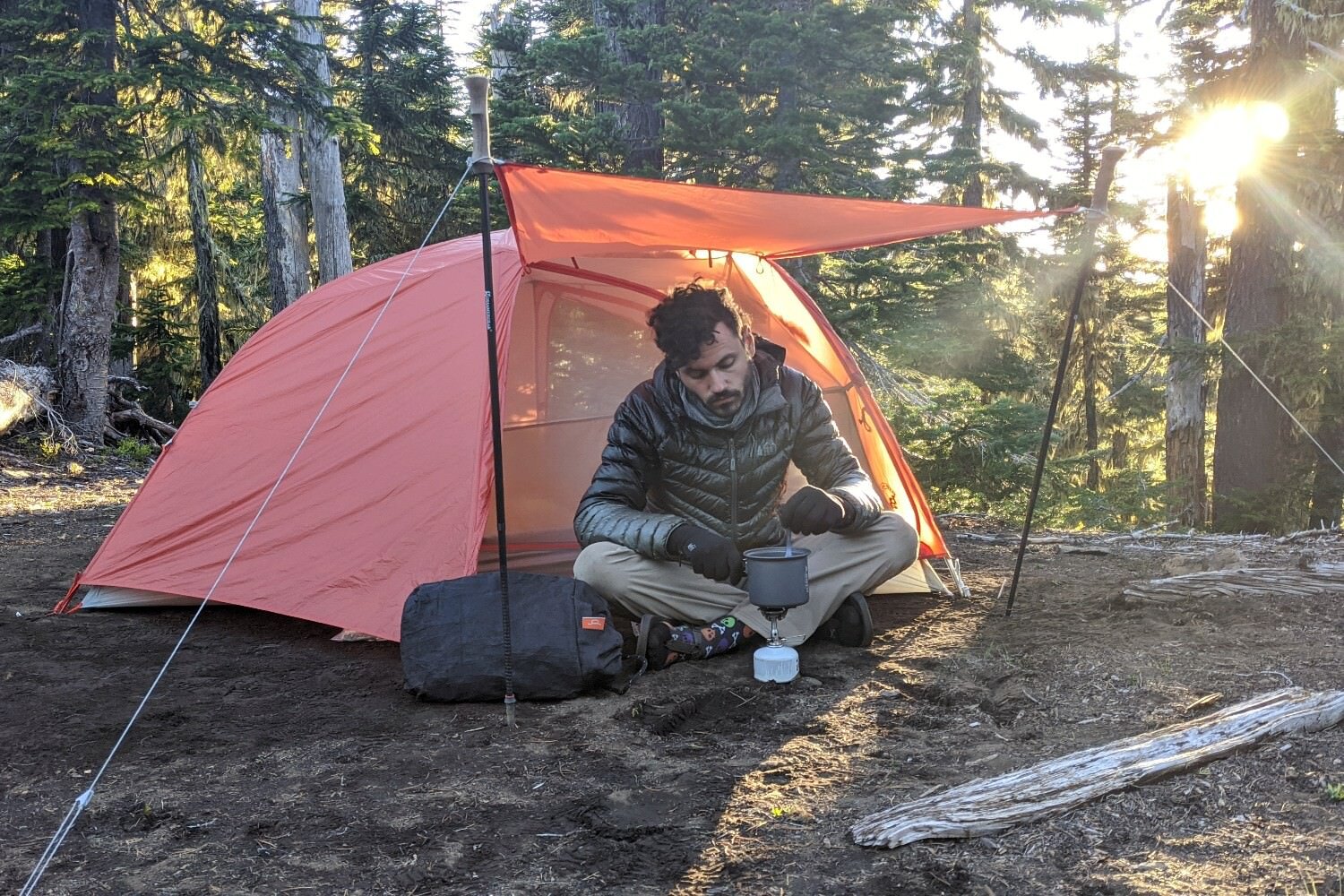
PACKAGED WEIGHT VS. MINIMUM TRAIL WEIGHT
When researching tents, you’ll likely notice a few different specs listed for weight and it can get a little confusing. Some manufacturers may even exaggerate how light a tent is to make it seem more appealing. Unfortunately, there is no required set standard for measuring backpacking tent weights across the industry, but here are some tips to help you decipher all the numbers:
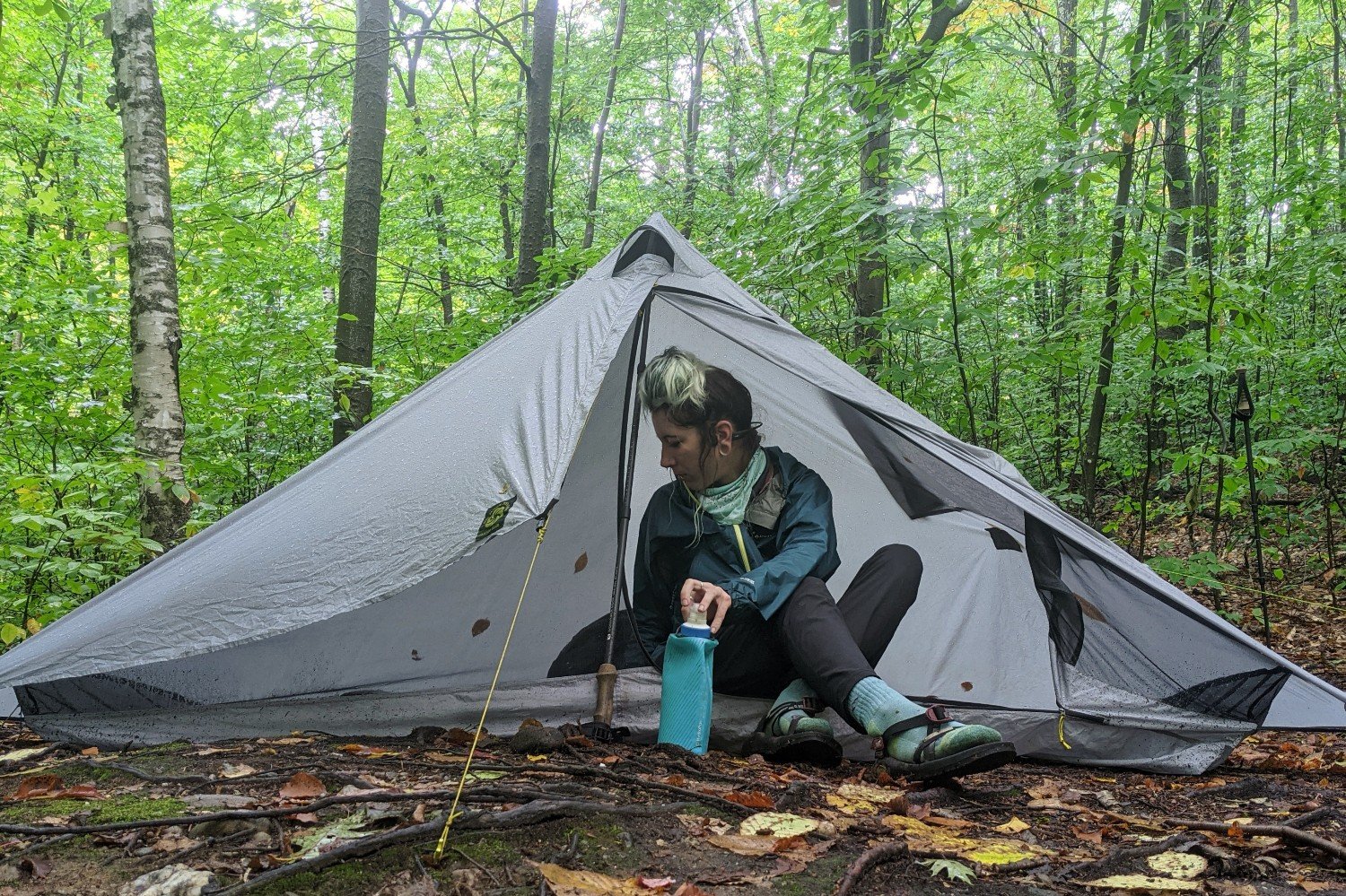
Packaged Weight
This spec refers to the weight of all parts of the tent plus any accessories it comes with when you buy it. This is usually the most accurate measurement to consider, and it’s the spec we’ve listed with all the tents on this list. After all, you’re going to be using tent stakes with your tent, right?
Minimum Trail Weight
This one gets a little hairy. Since there’s no required industry standard for calculating this, some manufacturers exclude more items than others. Minimum trail weight is generally accepted to mean just the essential components to keep you dry. It will always include the tent body, the rainfly, and the poles. This measurement usually excludes tent stakes (unless your tent is semi-freestanding), guy lines, and stuff sacks.
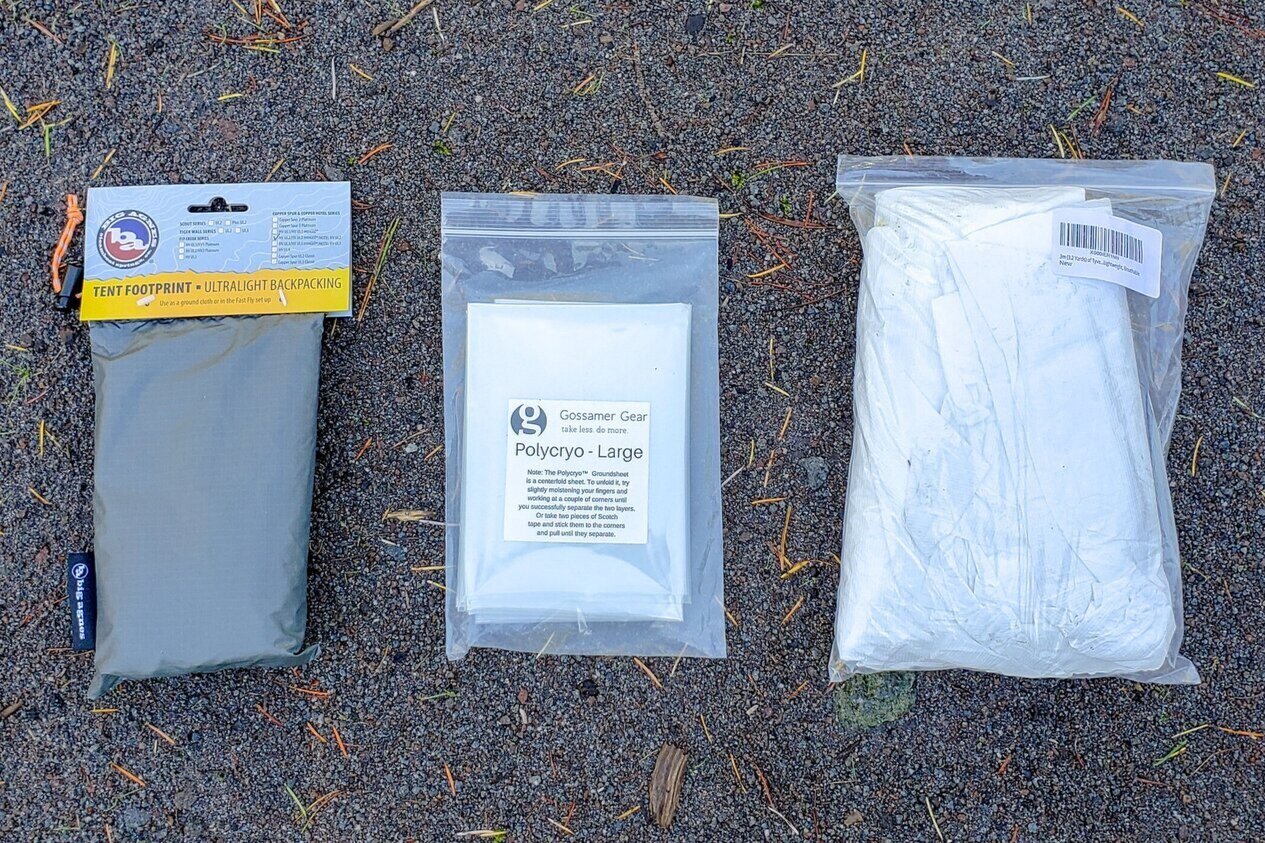
DO YOU NEED A FOOTPRINT?
Almost every backpacking tent on this list comes with the option to buy a footprint that will help extend the life of your tent floor. Footprints are not necessary, though, and many choose not to use them. It’s totally a personal choice, but a footprint will ensure that your tent floor lasts as long as possible. If you need help deciding if a footprint is right for you, check out our post Do You Really Need a Footprint for Your Tent.
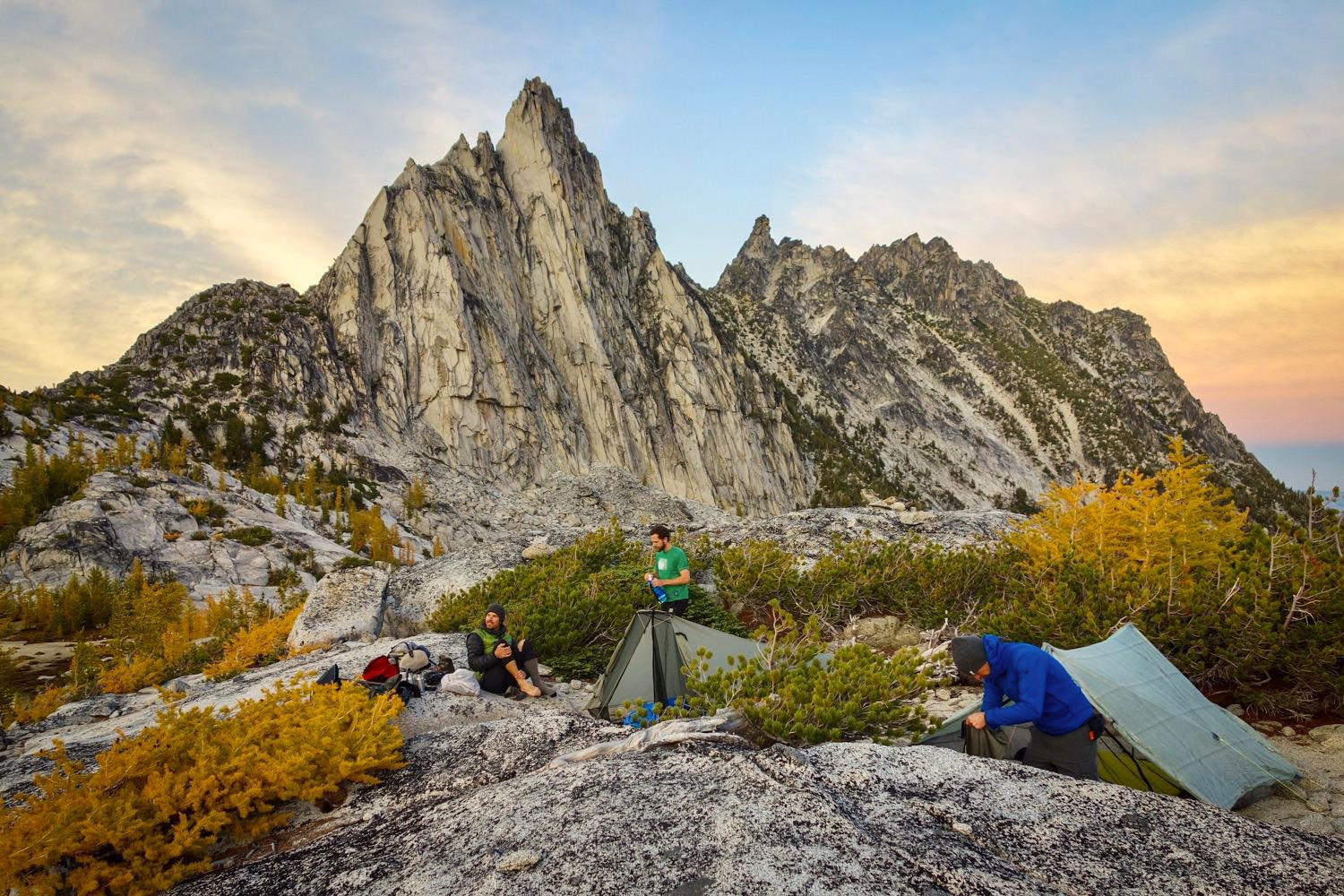
PROTECTION
A backpacking tent that doesn’t protect against the elements is worse than worthless, it’s dangerous. So be careful about extreme budget tents you’ll find elsewhere. Every tent on this list will provide excellent storm protection to keep you safe, dry, and warm.
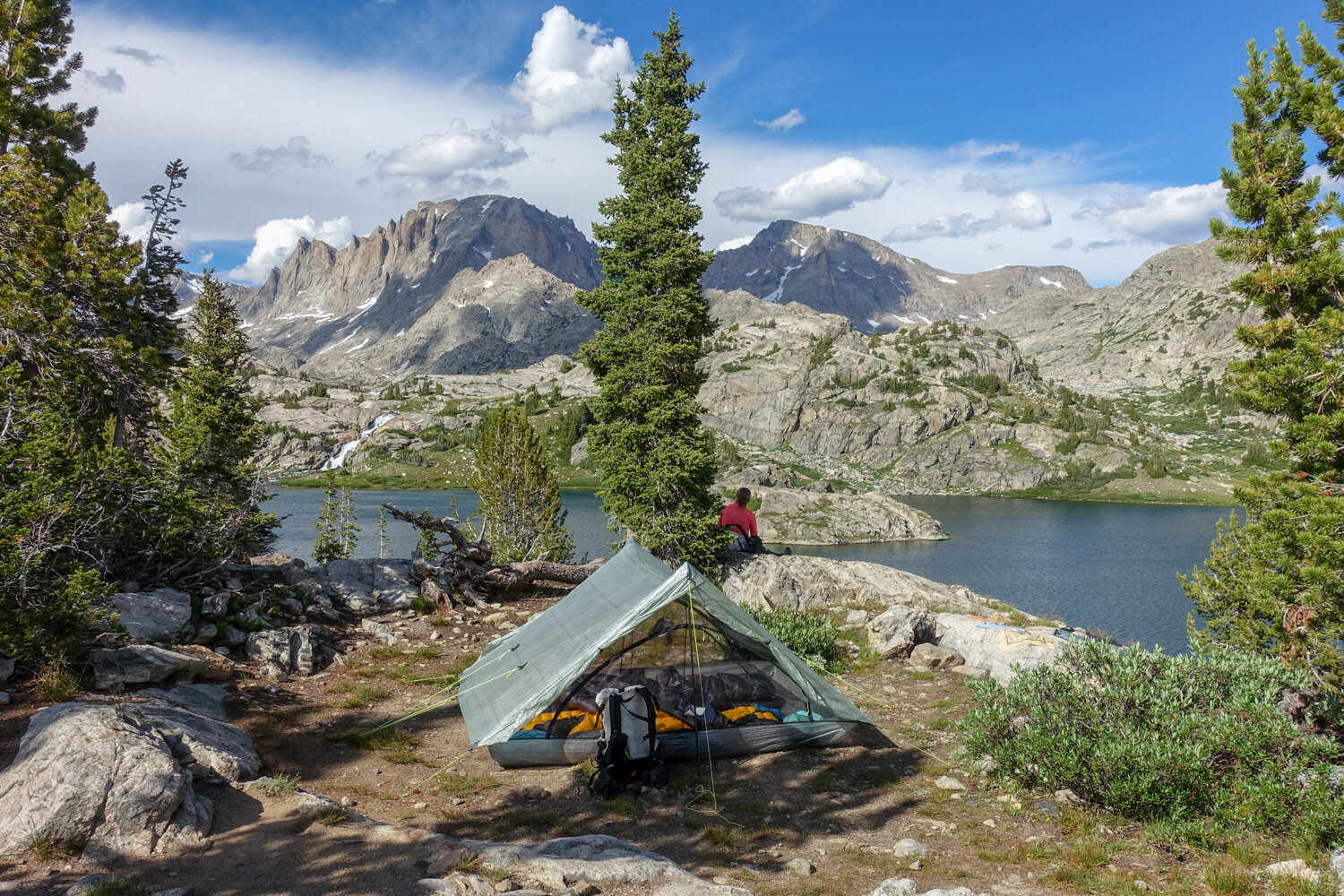
INTERIOR SPACE
Backpacking tents keep weight to a minimum by limiting interior space (and thus, use less material). One-person tents are great for dedicated solo hikers looking to travel fast and light. Two-person tents tend to be the most popular, because they strike a good balance between weight and interior space. Most two-person tents have just enough room for two sleepers and a few stuff sacks, with backpacks and extra gear stored in the vestibules. If you want more interior space for camping comfort, you may want to bump up one size in tents (for example, buy a three-person tent to fit two hikers). Just remember, interior tent space is a tradeoff between comfort and weight. Check out our Tent Size Guide for more information on choosing which model to go with.
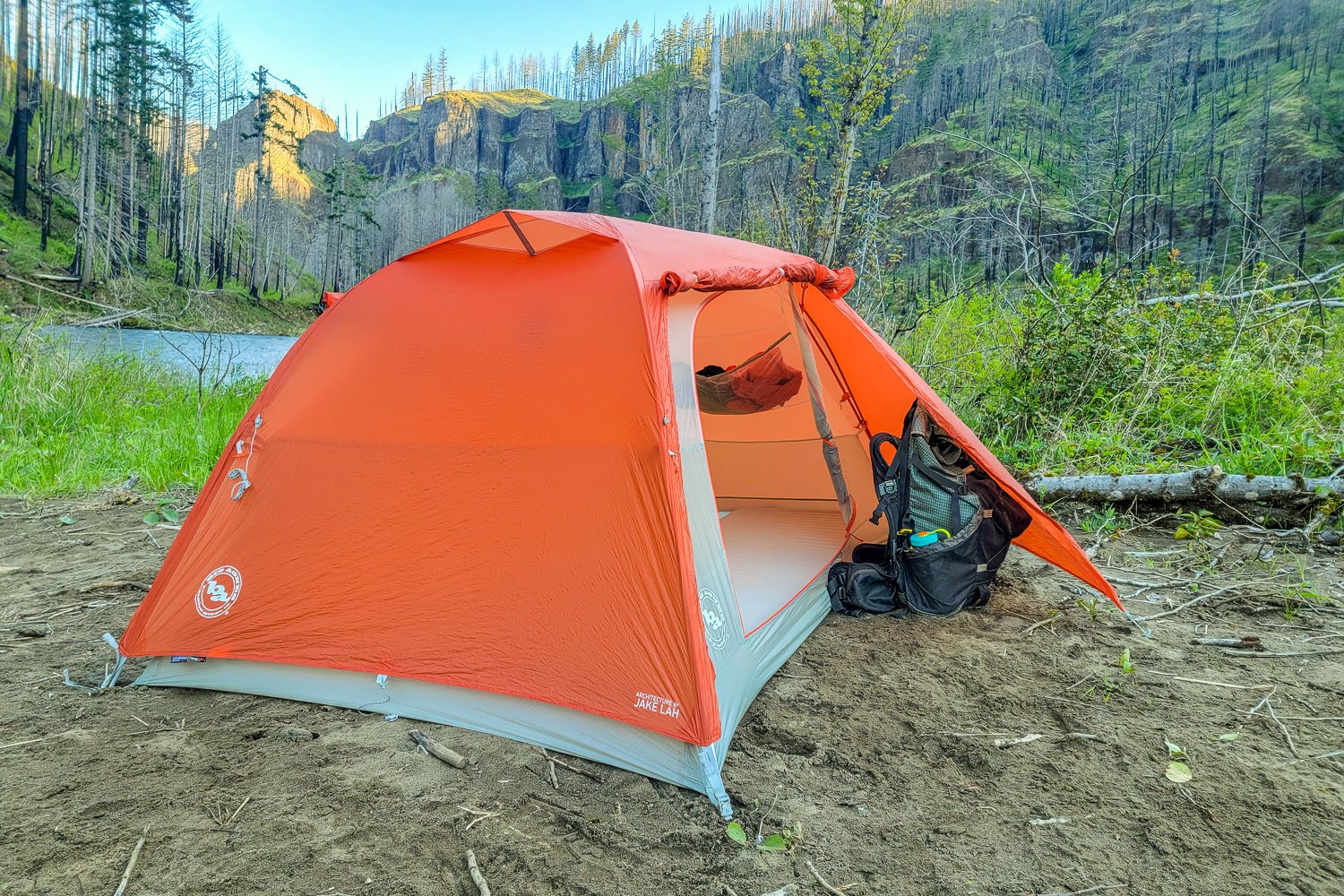
SEASON RATING
Three-season shelters are the most popular backpacking tents and the style we’re focusing on in this guide. They’re built for spring, summer, and fall trips where you’ll need to keep bad weather out while promoting ventilation, which helps keep interior condensation to a minimum. Three-season tents can usually handle a little snow, but they’re not made for heavy snow and harsh winter conditions. If you’re looking for a winter worthy tent, make sure to check out our list of the Best 4-Season Tents.
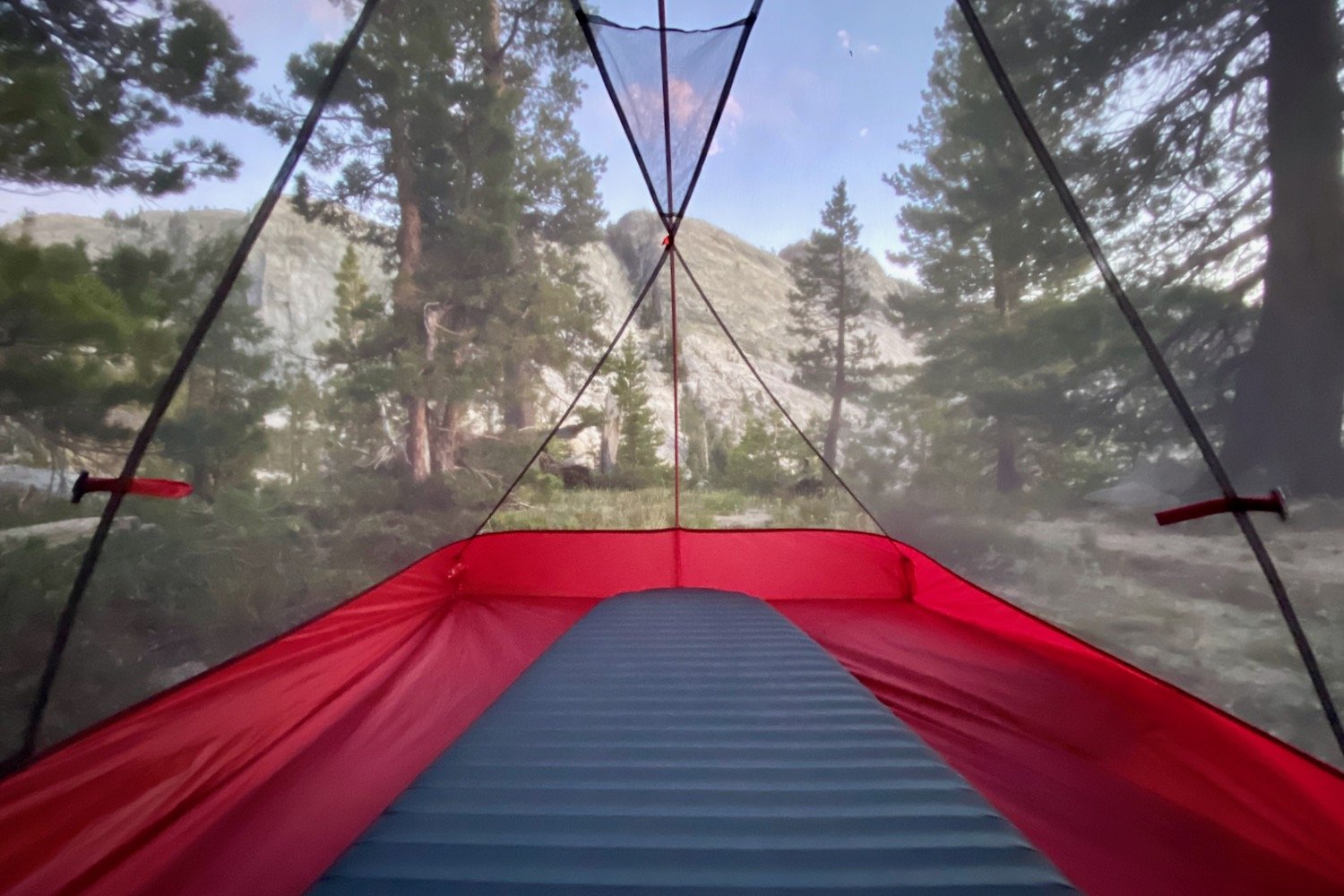
SETUP
Freestanding tents are generally preferable because they’re easier to use and quicker to pitch. They come with a fixed pole system that can be set up almost anywhere – even on solid rock. Non-freestanding tents use stakes, guylines, and trekking poles for pitching. They save weight by cutting out tent poles, but require more time/space to pitch and will take more practice to master.
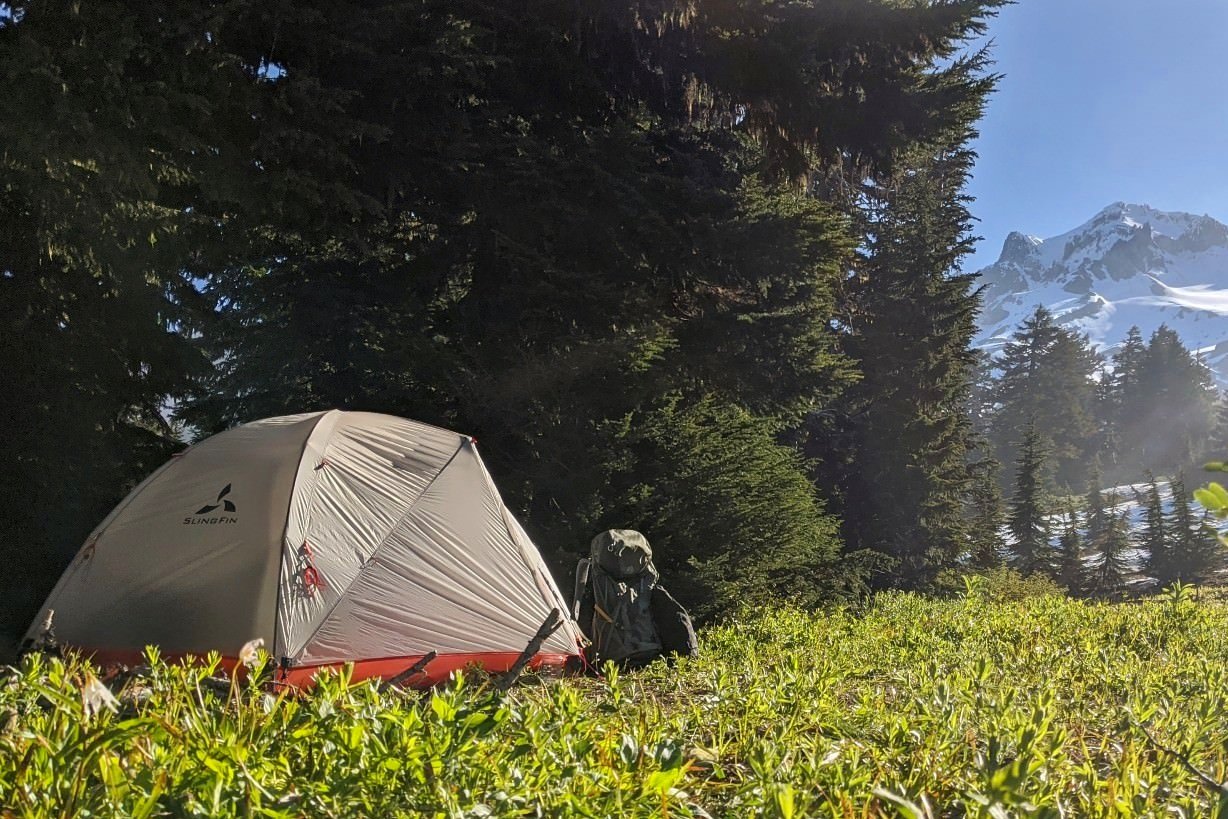
DOORS & VESTIBULES
If you plan on sleeping two people in your tent, it’s more comfortable to have two doors and two vestibules. Having separate entrances will ensure that you’re not climbing over a tentmate and two sets of gear every time you want to get in or out of your tent. That’s a huge benefit, and it’s why almost all of our backpacking tent recommendations have two doors and vestibules.
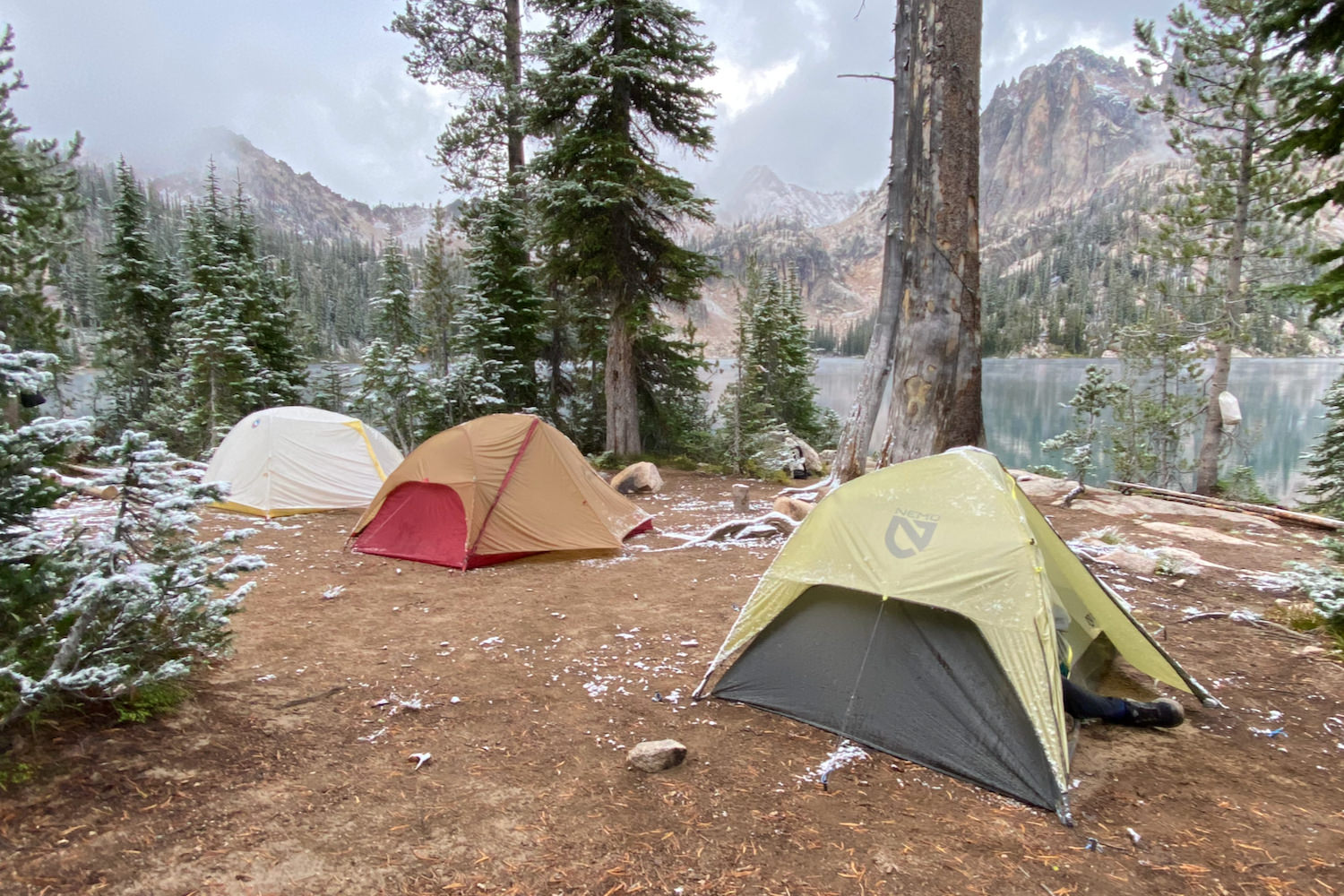
WALL CONSTRUCTION
Double-wall tents come with two separate parts – a mesh tent body and a rainfly. The mesh inner-tent acts as a barrier from condensation that forms on the inside of the rainfly. Single-wall tents reduce weight by attaching the fly sheet directly to the mesh inner-tent, but that leaves hikers vulnerable to interior condensation in wet/cold conditions. Rubbing up against a wet tent interior is the pits, so we mostly recommend double-wall tents unless you usually backpack in arid, dry climates. For ultralight hikers open to the idea of single-wall shelters, have a look at our Best Ultralight Tents list.
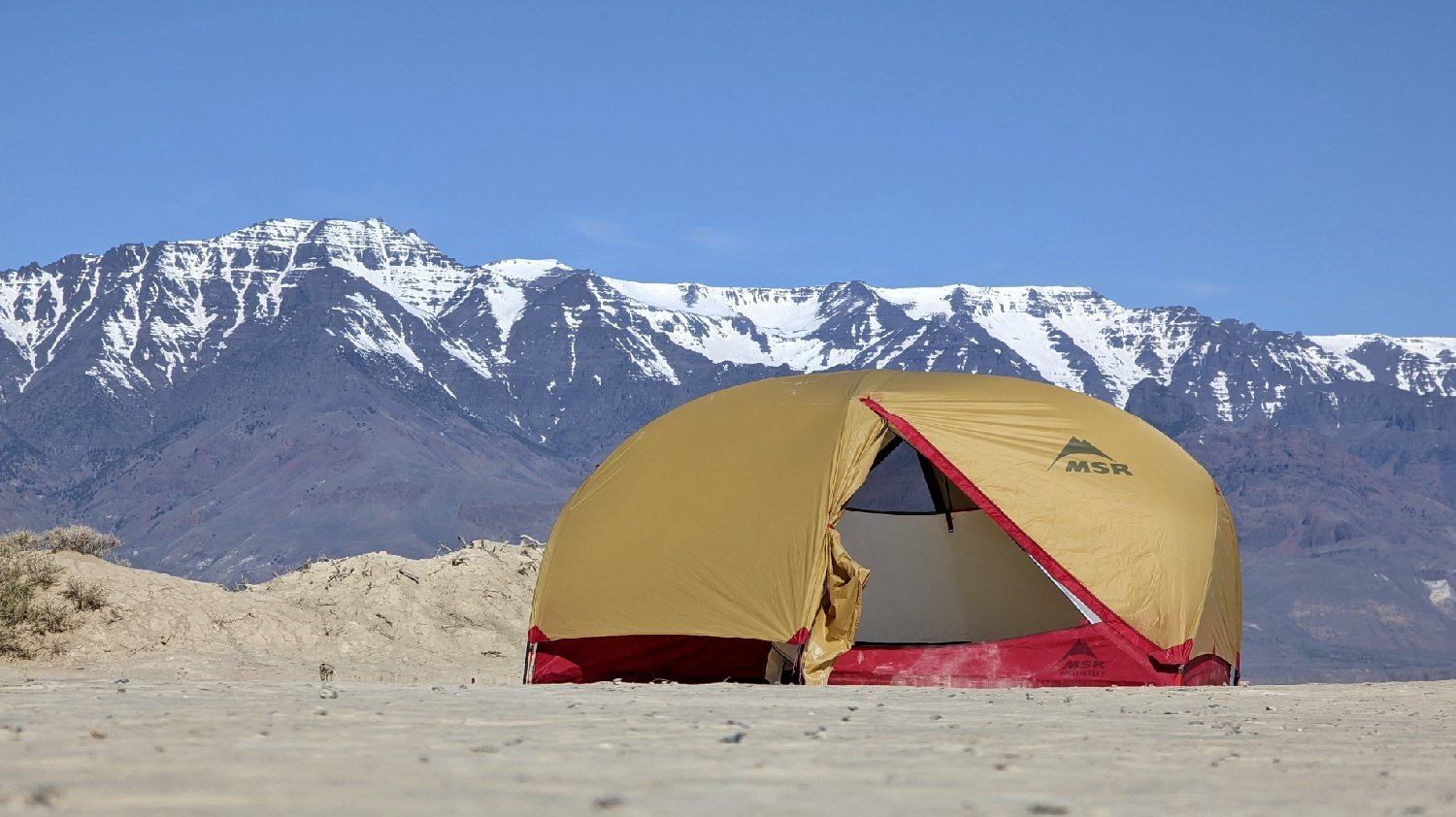
DURABILITY
The main trade-off with lightweight backpacking tents is that they’re built using thinner materials, which tend to be less durable than heavy-duty shelters. That said, ultralight tents will literally last for thousands of miles if treated with care. It’s also important to remember that a sharp stick or rock will puncture just about any kind of tent fabric. If you’re tough on gear and don’t want to deal with lightweight materials, we recommend choosing one of our heavier recommendations built for durability or adding a footprint to to increase the durability of your tent floor. For our personal use, we think lightweight tents are well worth the tradeoff.
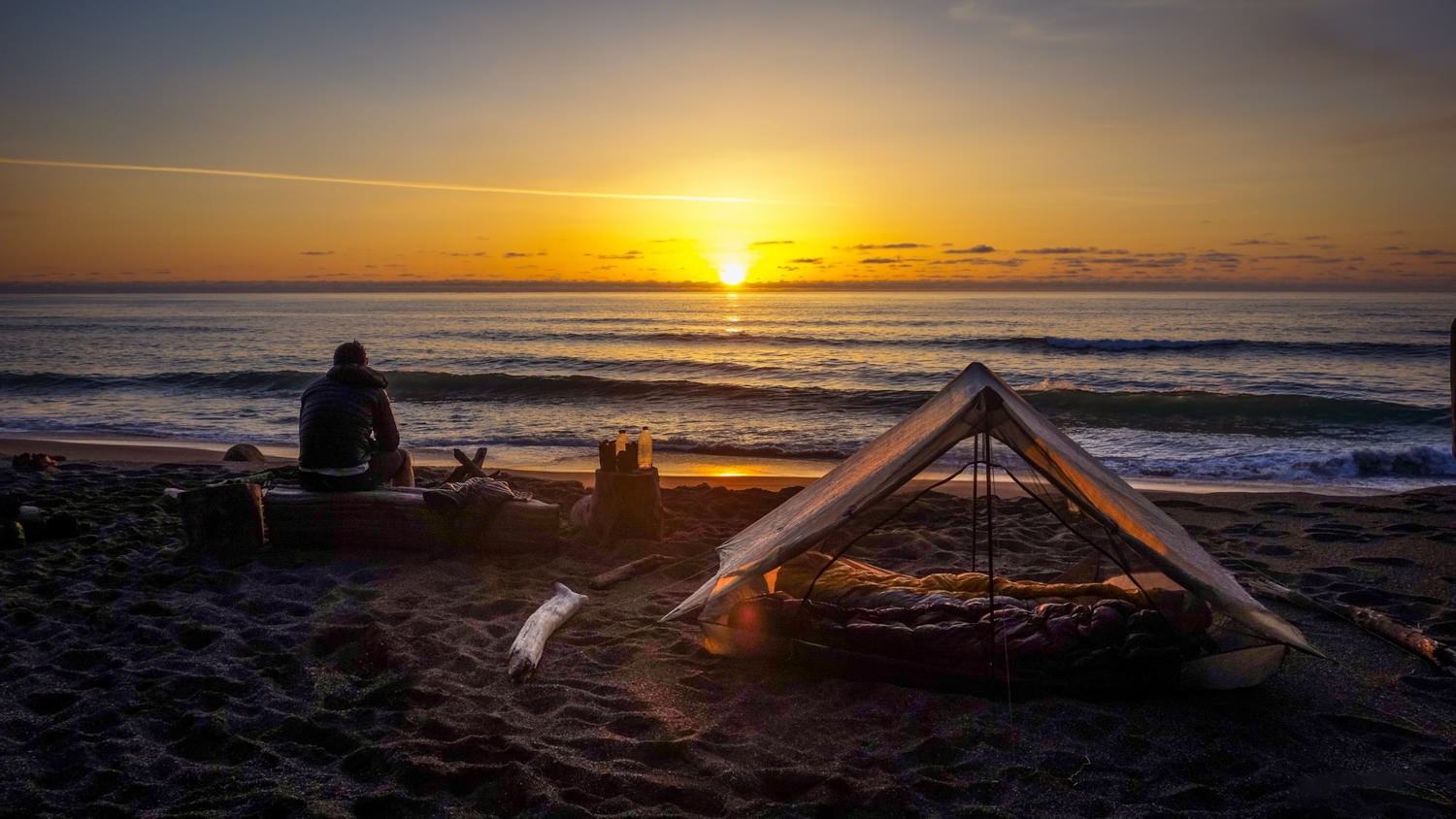
Honorable Mentions
The following backpacking tents didn’t make our final list, but they’ve still got a lot of good things going for them. You never know, one of these tents might be perfect for you:
REI has made some of our favorite tents over the years, but few have been as impressive as the Flash 2. This tent was a new offering from REI in 2023, but it’s currently out of stock for the foreseeable future. It’ll be back at some point down the line, which is why we felt it still deserved an Honorable mention on our list.
This freestanding tent has a weight and interior volume that rivals some of the most popular backpacking tents, but it costs far less than anything in its class. With its unique pole architecture, the Flash 2 manages to feel more spacious than tents with the same dimensions – like the Big Agnes Copper Spur 2. The headwall of the Flash 2 stands vertically and is supported by an arch pole that pulls the sidewalls out. As a result, you end up with more headroom where you need it most.
We’re eagerly looking forward to the return of the REI Flash 2.
The affordable REI Trail Hut 2 is almost identical to the REI Trailmade 2 on our main list. The biggest difference is that the Trail Hut has a ridge pole at the peak that creates more headroom than the Trailmade has. The other key difference is that the Trail Hut has more opaque nylon on the walls for privacy, while the Trailmade includes more mesh on the walls for airflow.If you’re after a crossover tent that you’ll mostly be using for car camping and only backpacking with it occasionally, you’ll probably find this tent more comfortable. If you’ll mostly be using your crossover tent for backpacking, we recommend saving the money and going with the lighter Trailmade 2.
This tent feels a little tight for two, but it’s a roomy option for solo hikers. This tent is very similar in design to our top pick – the Big Agnes Copper Spur HV UL2. We prefer the ridge pole design on the Copper Spur since it pulls the headroom out more and creates more interior volume at the peak where you really want it.
The Dragonfly is very light for a freestanding tent and has a tiny packed size, so it’s a good choice for hikers looking to shave weight and bulk from their packs.
The proprietary OSMO fabric on the Dragonfly makes it a great choice for hikers who frequently go out in foul weather. OSMO sags less than sil-nylon when wet, doesn’t absorb water, and stays waterproof for longer than standard coated fabrics.
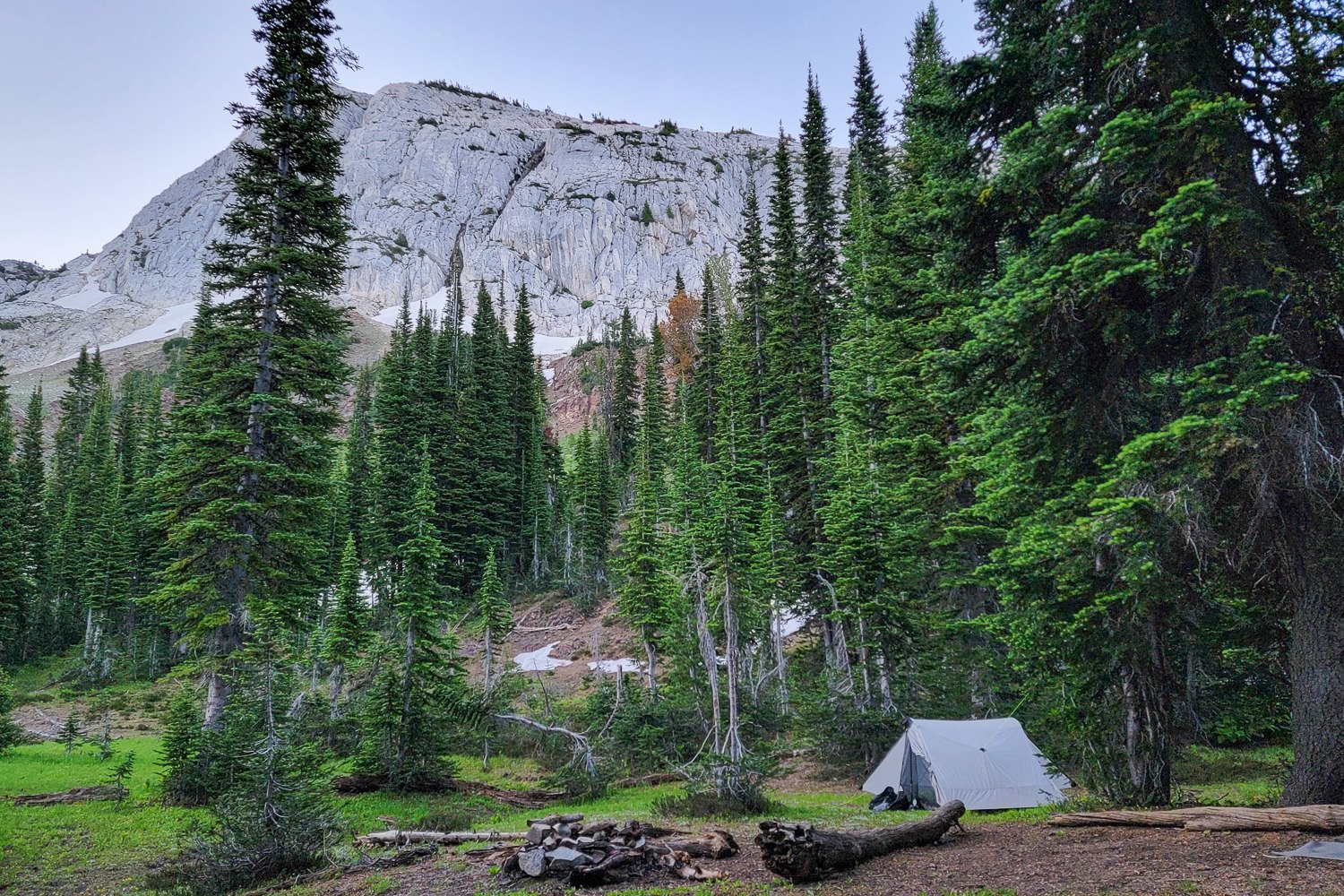
Conclusion
There are a lot of big and small differences between backpacking tents but investing the time to find the right one is worth it. Whether you are counting – and minimizing – ounces, or don’t mind the extra weight if it means you get to spread out at the end of a long day, we hope out guide has you pitching your perfect tent this backpacking season. Happy trails!



